
Palma de Mallorca or simply Palma is the historical and tourist center of the island of Mallorca, as well as the main city and port of the Balearic Islands.
Palma is one of the oldest cities in Europe, the chronicle of which traces its history back to the Roman conquests in 123 BC.
Today, Palma is one of the most visited cities of the Balearic Islands, preserving in its structure the historical center where an Arab city called Medina Mayurka once stood, from which practically nothing remains.
The historical center of Palma is the old town, where the main tourist life of the city's guests takes place.
The old Town of Palma is characterized by boulevards and narrow cobbled streets, small squares, cathedrals and churches, the main of which is the Cathedral of Palma. Also in the old town there are: Almudena Palace, which now houses a museum, Arab baths, museums and historical buildings, standing in dense rows along the streets and in which cafes, restaurants and bars, shops, boutiques and accommodation facilities (hotels, apartments, guest houses, hostels, etc.) are now located.

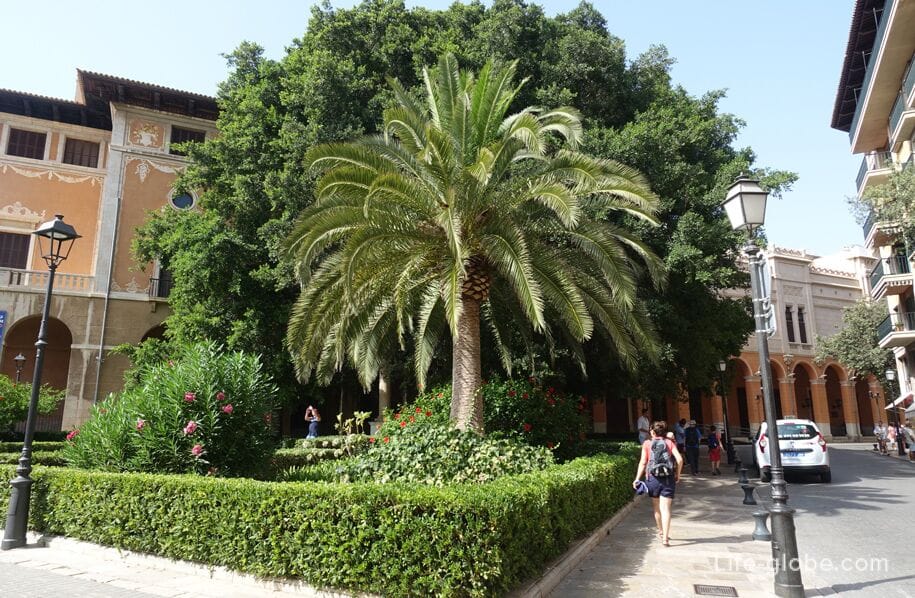
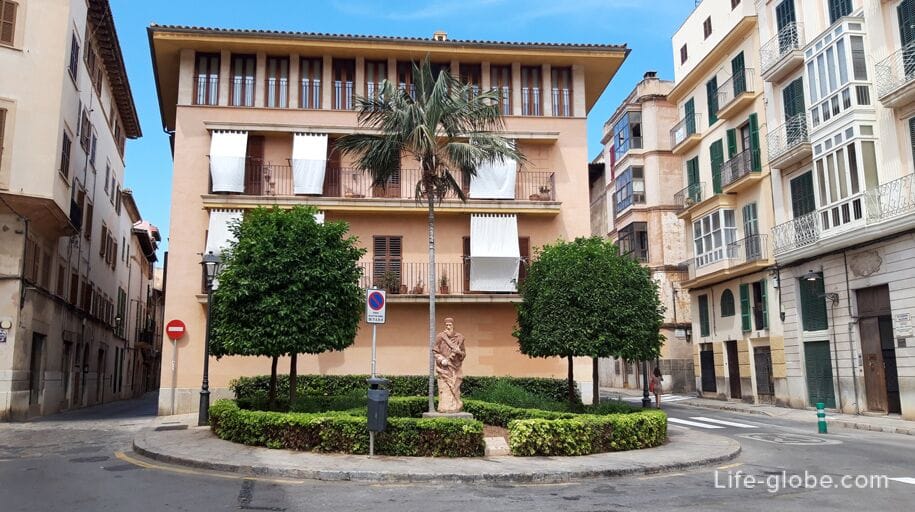
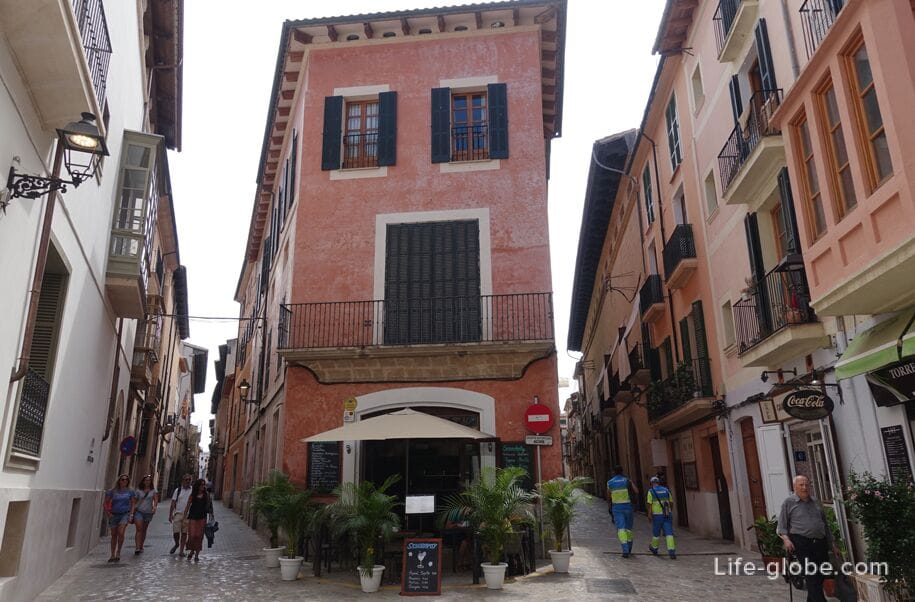
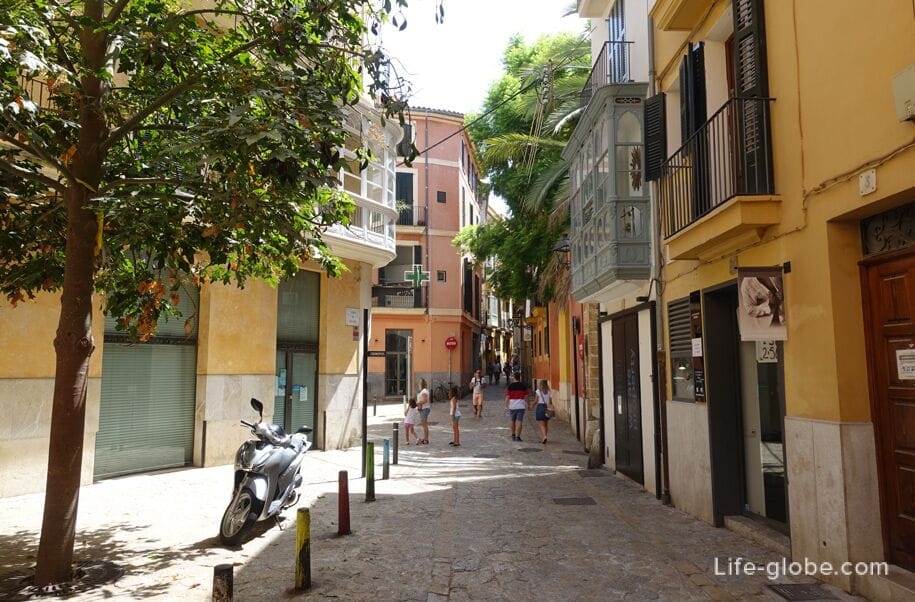

The old town of Palma is located in the very center of the city and runs from the seaside boulevard Paseo Maritimo (Paseo Maritimo) deep into the city.
The boulevard offers beautiful views of the old town of Palma, including the former defensive walls. More about Paseo Maritimo...

Beyond the Paseo Maritimo is a beautifulSeaside Park (Spanish: Parque del Mar, Catalan - Parc de la Mar), also known as the "Park of the Sea" or the park by the sea, and is one of the largest urban parks of the city of Palma.
The park was built in the 1970s on an empty site, after the construction of the highway and the embankment.
In the park: a salt lake with a fountain, places for walking and relaxing, trees and palm trees, an esplanade, sculptures, several cafes and restaurants and a covered parking lot. More about the Seaside Park...

The seaside park is separated from the old town by the old city wall (now restored) along which you can walk and from which you can enjoy wonderful panoramic views, including the Bay of Palma (the Mediterranean Sea).
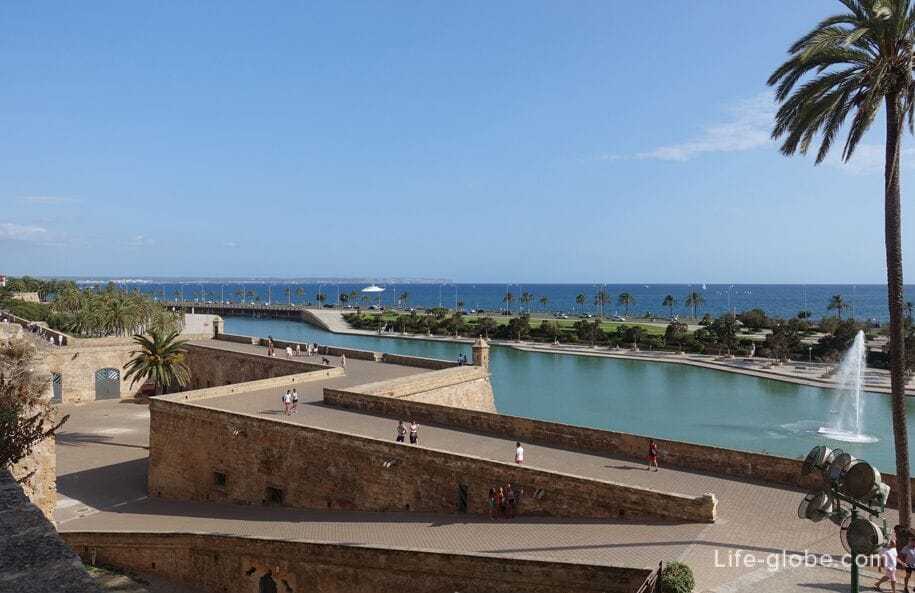
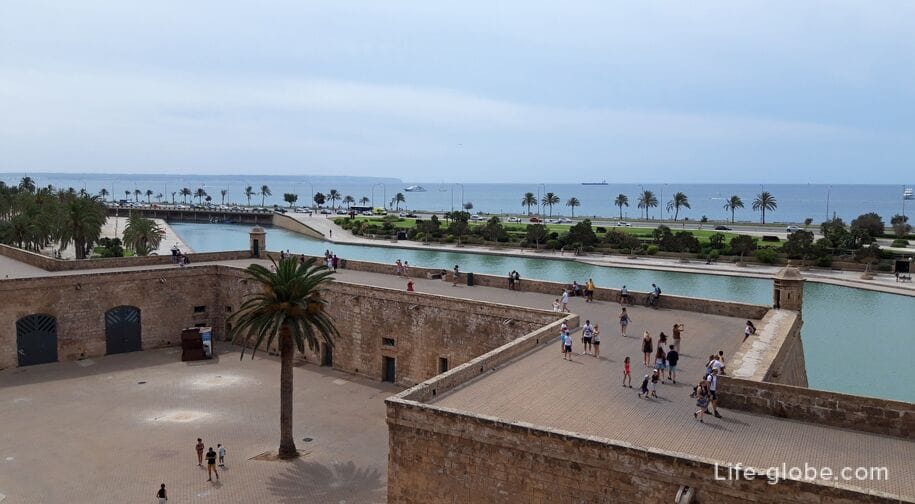
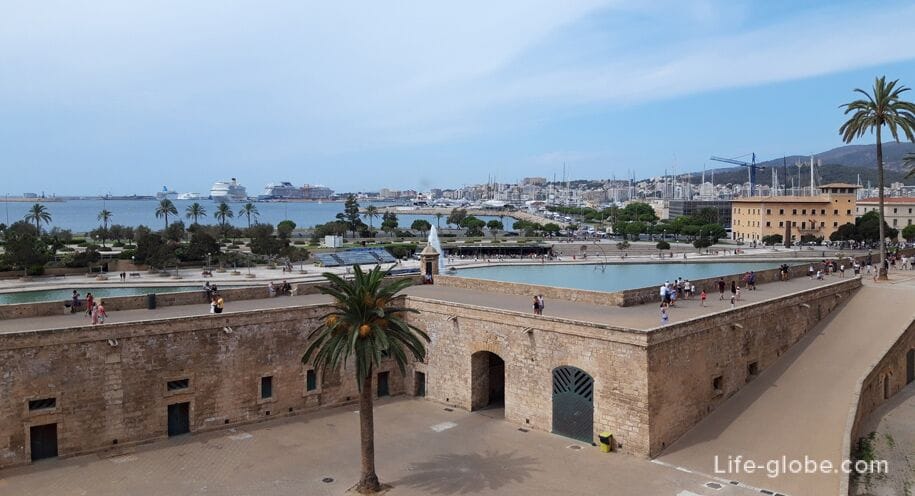

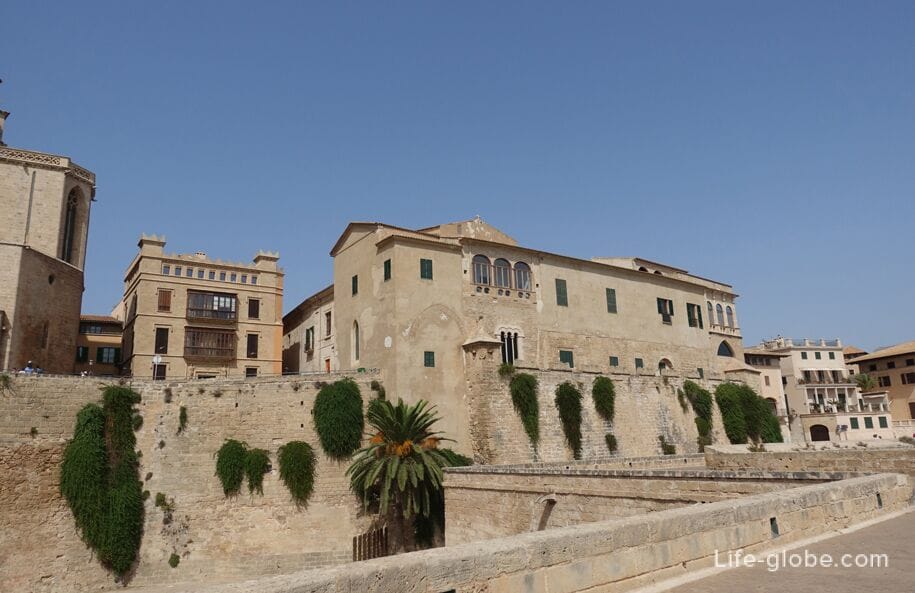
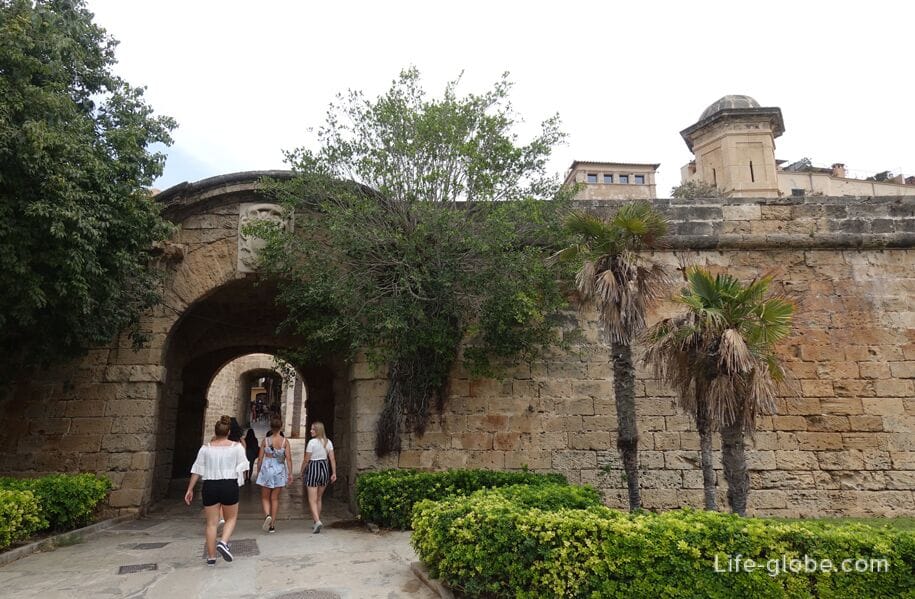
The Cathedral of Santa Maria, also La Seu (Spanish: Catedral de Santa María de Palma de Mallorca), is the main dominant of Palma.
The Gothic-style cathedral was built on the site of an Arab mosque in 1230-1630.
Over the course of history, various architects have worked on the cathedral, including Antonio Gaudi, who at the beginning of the 20th century adapted the interior of the cathedral to new liturgical and pastoral requirements.
The central nave of the cathedral has a height of approximately 44 meters, which makes it one of the tallest cathedrals in Europe.
Today, the cathedral can be visited for a fee, as well as with an excursion to walk through the "funerary world of the cathedral" or its terraces, from which to admire the panoramas of Palm Trees and the Mediterranean Sea.
Cathedral address: Plaza de la Almoina S/N 07001 Palma de Mallorca.
Cathedral website: catedraldemallorca.
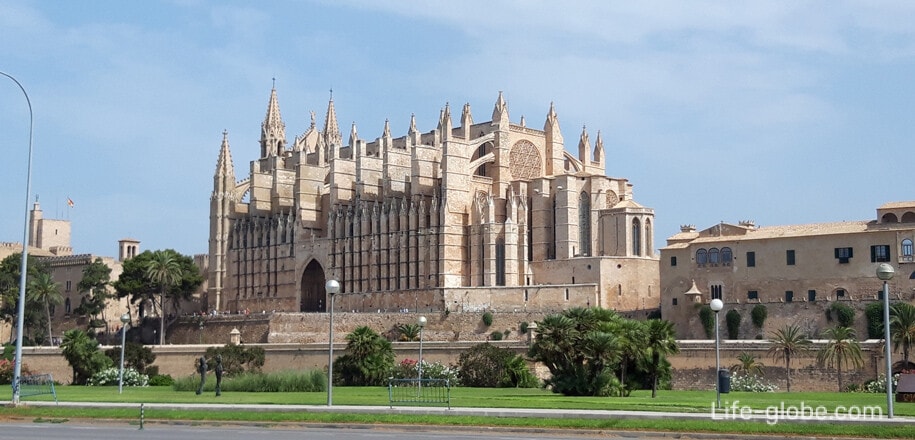
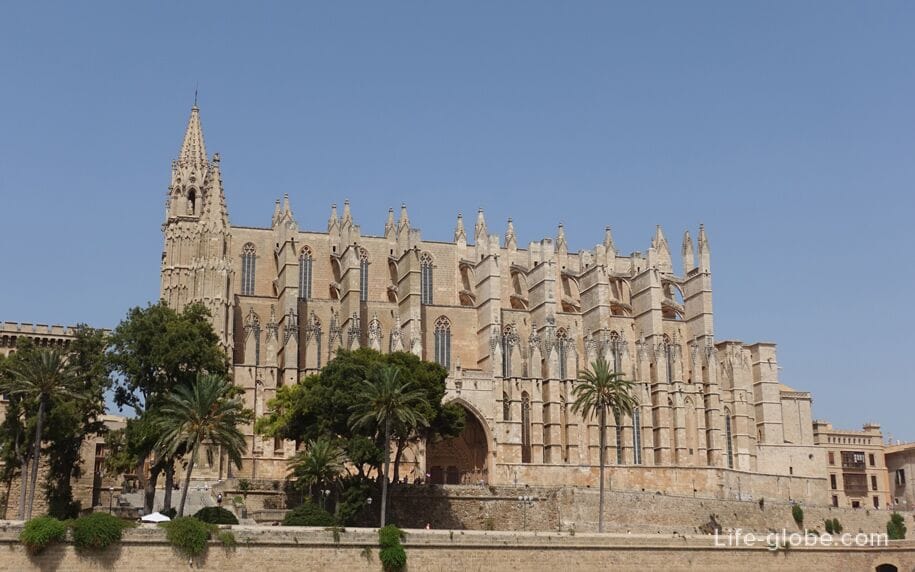
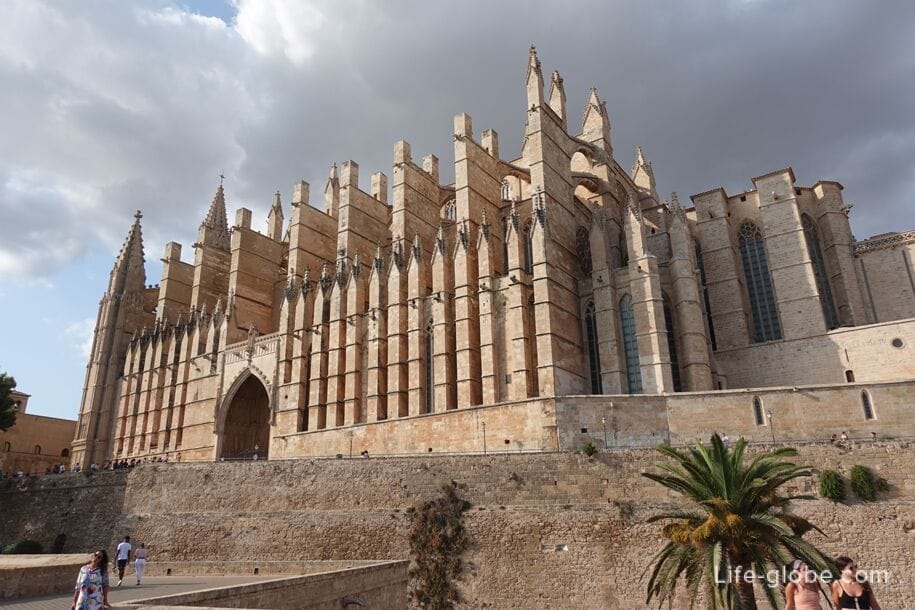
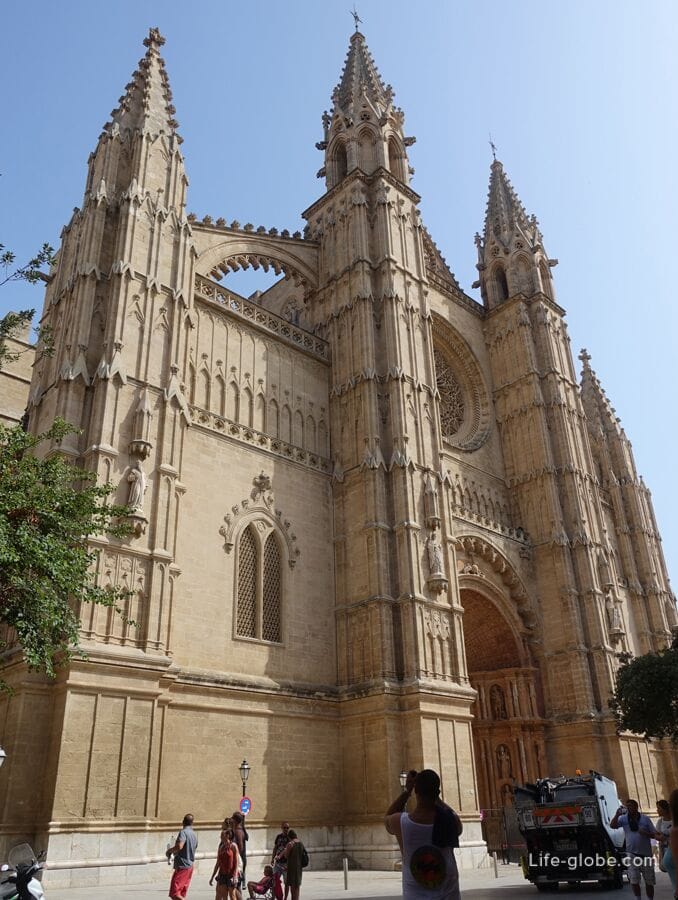
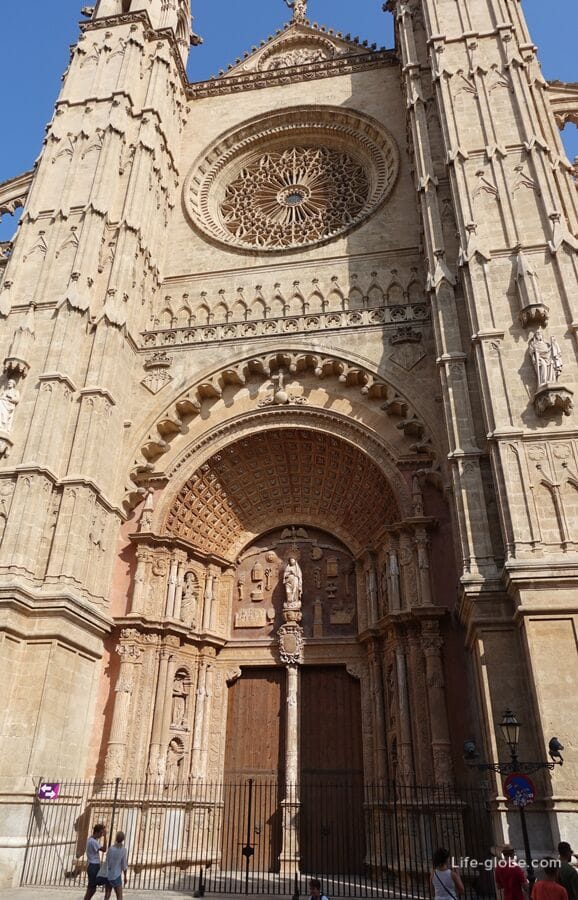
On the north side of the Cathedral of Palma, there is a small and cozy La Seu Square (Placa De La Seu), surrounded by historical buildings.
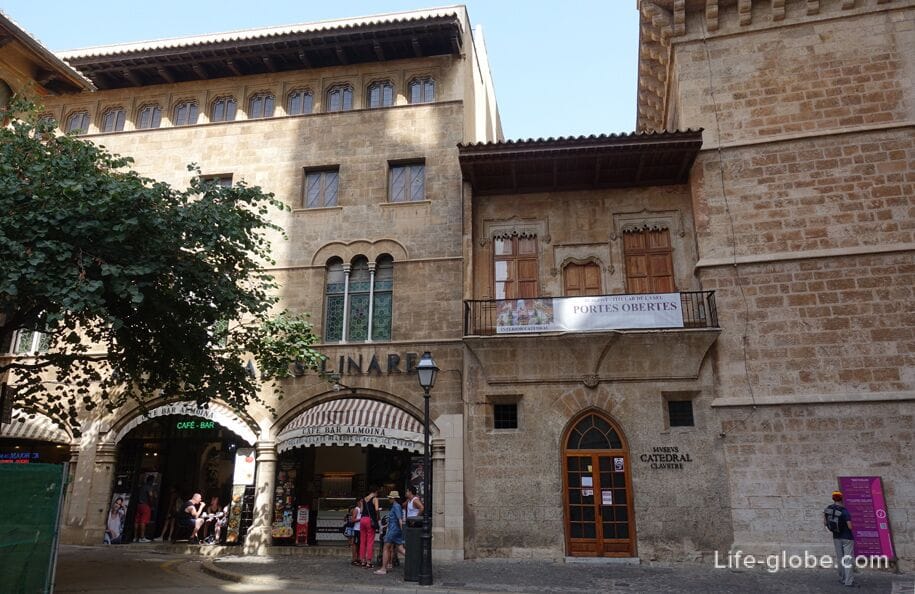
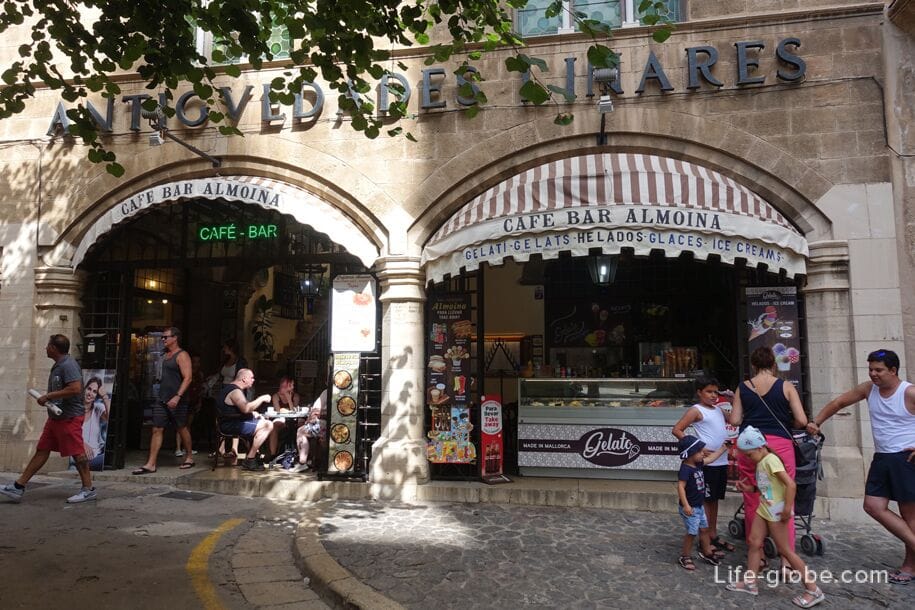
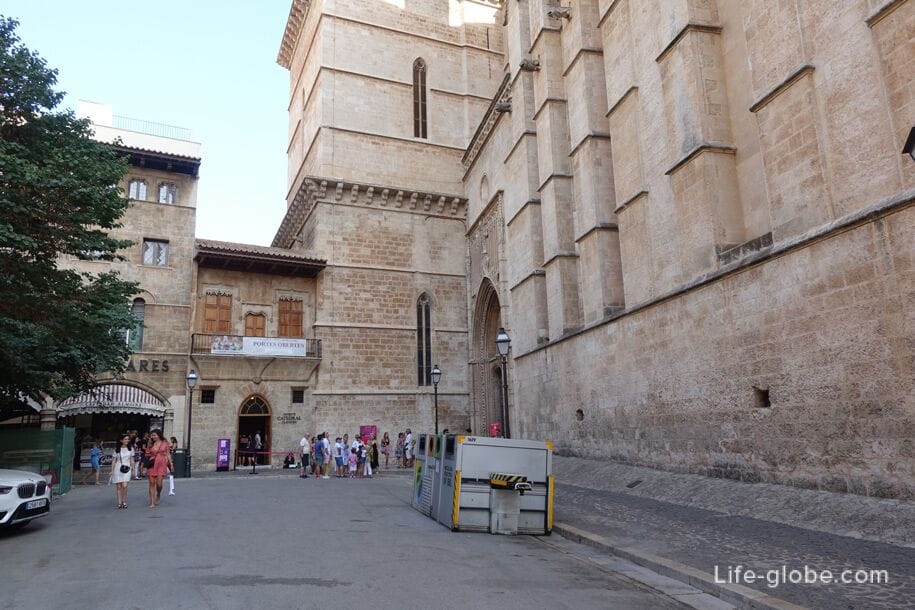
The Royal Palace of Almudena or Almudain (Palacio Real de La Almudain) is located opposite the Cathedral of Palma.
The palace was built in 1281 on the foundation of the previously existing Arab fortress-Alcazar and served as the residence of the kings of Mallorca.
Today there is a museum in the palace. Entrance is paid.
Palace address: Palau Reial s/n. 07001 Palma de Mallorca.
Museum website: palacio-almudaina.


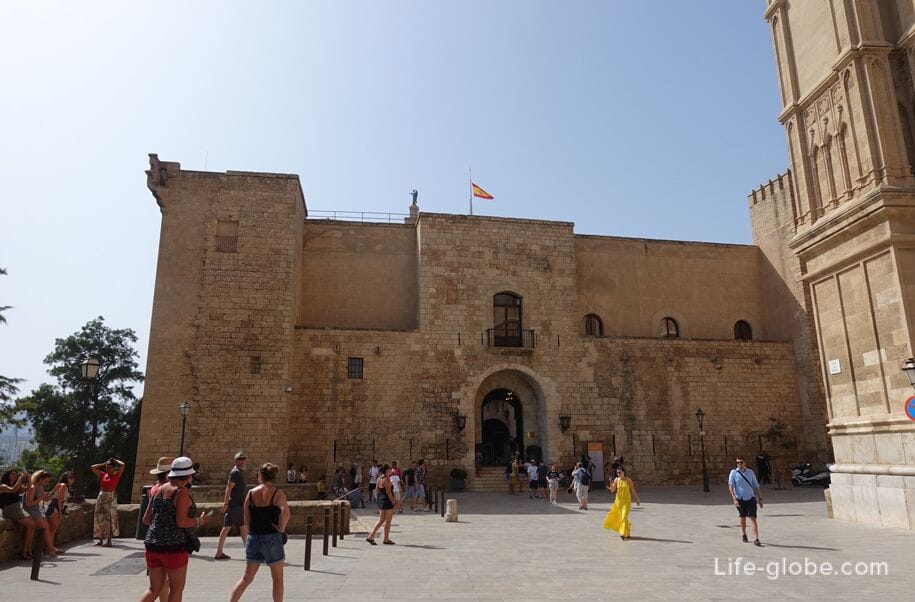


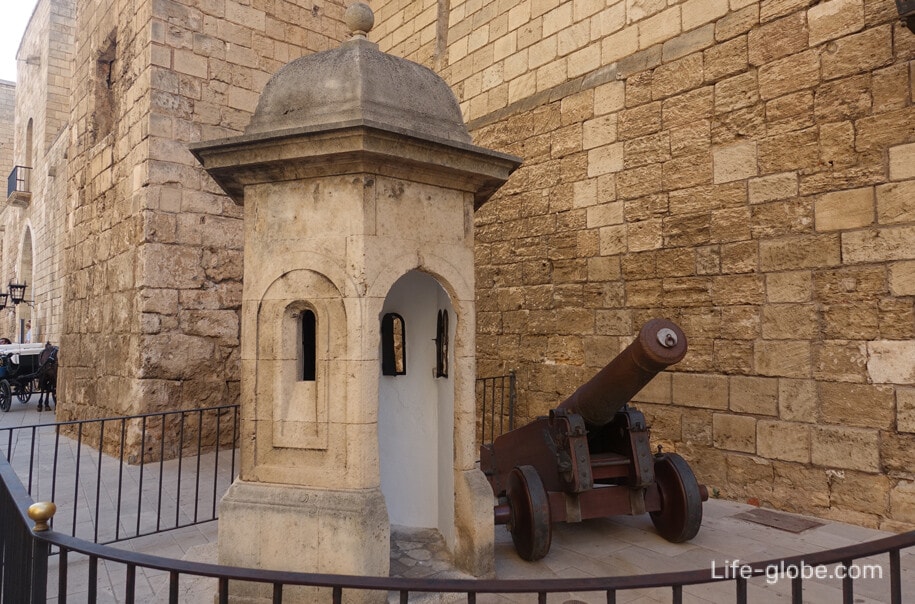
The Cathedral of Palma and the Almudena Palace are the main attractions of the city and together represent a beautiful ensemble, gorgeous views of which open from the city embankment.
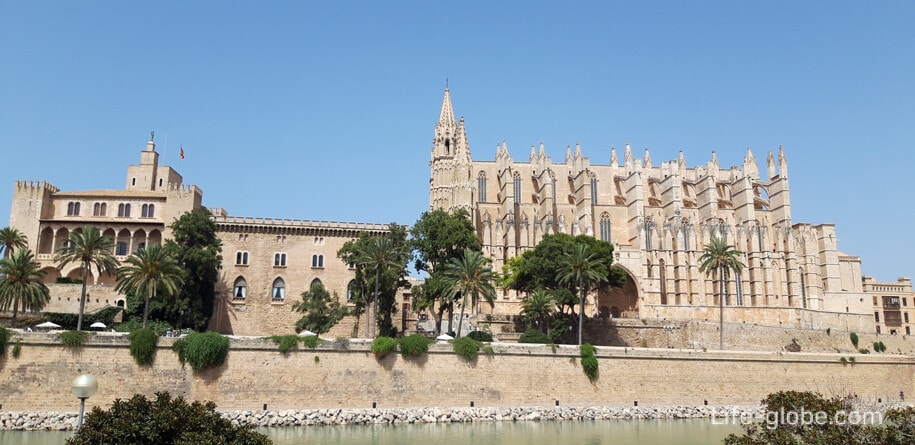
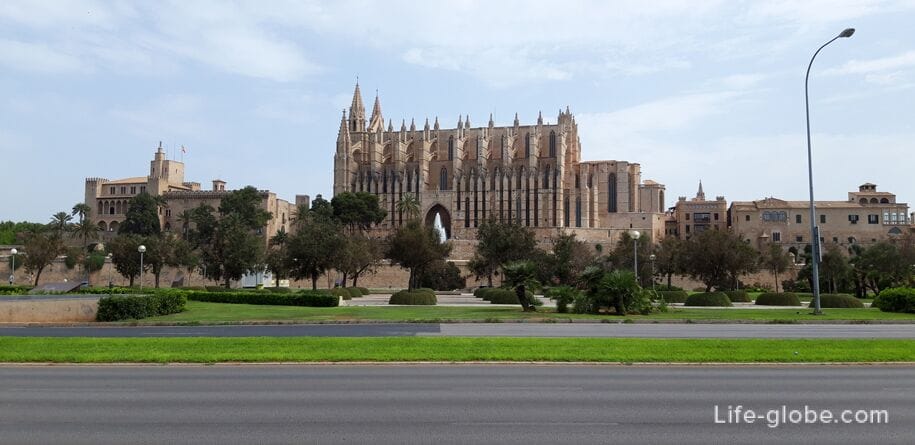
The Royal gardens were the gardens of Almudena Palace and are known as Parc Hort del Rey or simply Parc Rey (Parc Hort del Rei / Jardines de S'Hort del Rei).
Currently, the Royal Gardens are a small public space - a shady park area with Arabic-style fountains, a pergola, sculptures, lush vegetation and places to relax. More about the Royal Gardens...

The Palace of Darkness (Palau March) was once the residence of the rich and famous Markov family (Palau March) and one of the most luxurious mansions of Palma.
The building attracts a beautiful outdoor terrace with views of part of the old town of Palma.
Now the building houses the Parliament of the Balearic Islands and a museum with collections of sculptures, paintings and reconstruction of part of the palace.
The address of the palace: Carrer del Palau Reial, 18, 07001 Palma.
Website: fundacionbmarch.
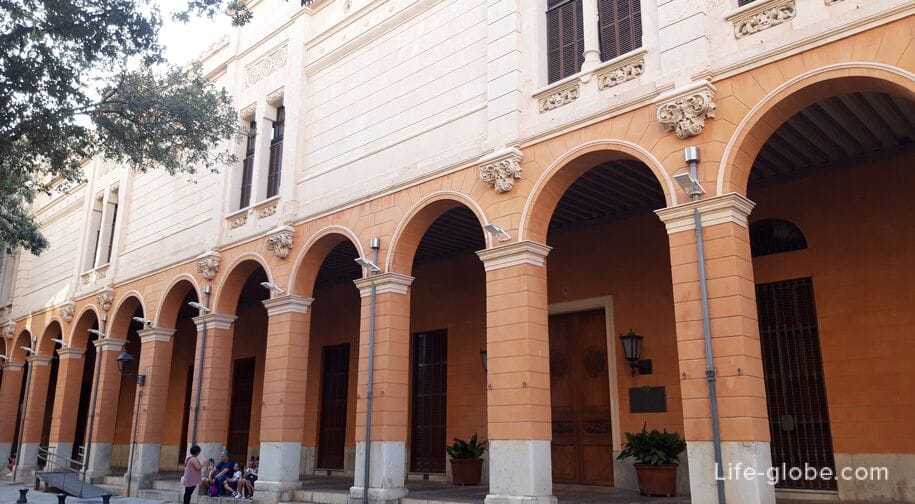
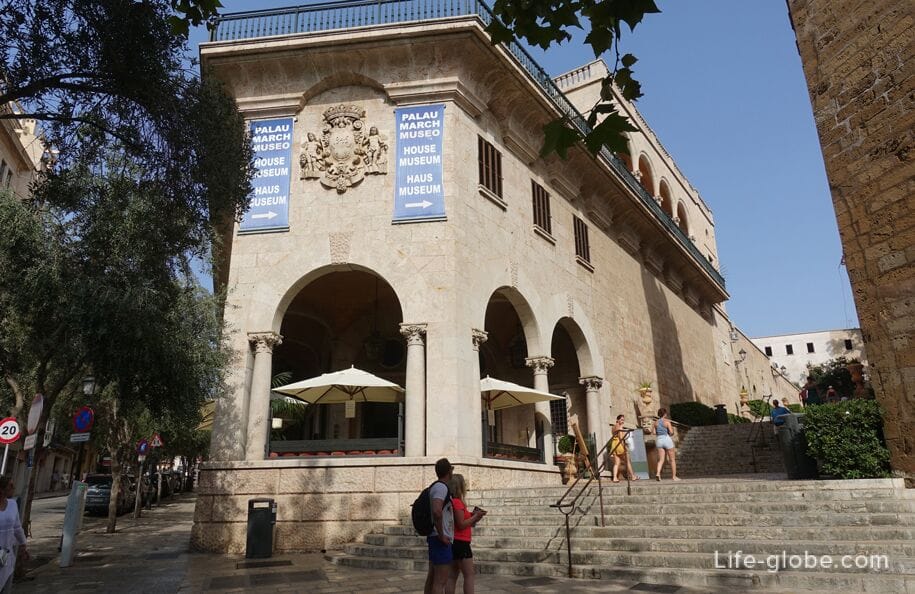
The Bishop's Palace or Bishop's Palace dates back to the final establishment of the episcopal see in 1238 and to Ramon de Torrella (1238-1266) as the first bishop of Majorca.
Since the palace has been modified over the course of history, it does not represent stylistic unity, although it mainly corresponds to the Gothic style.
The building has a rectangular shape and an inner courtyard. Access to the courtyard is through the main facade with a gate built in 1616.
In the center of the courtyard there is a monument to the Sacred Heart of Jesus, created in 1932 in honor of Archbishop Josep Miralles Sberta (1930-1947). The work of sculptor Mikel Arcas. On the pedestal of the monument are the coats of arms of the bishop, the city of Palma, Pope Pius XI and a commemorative inscription.
Today, the Diocesan Museum of Christian Art of Mallorca (Museu Diocesa) is located within the walls of the bishop's palace. Most of the museum's collection is of religious origin, but also contains archaeological objects, decorative art and ethnographic value. The interior spaces of the museum include a series of large Gothic arches and a stained glass window designed by Antonio Gaudi and dedicated to Bishop Pere Juan Campins; on the ground floor there is a corridor with vaulted mares, which used to form part of the palace stables and in which the remains of a wall of the late Roman period are visible, as well as a large gabled window-facade overlooking the sea.
The address of the palace: Carrer del Mirador, 5 (Palau Episcopal) 07001 Palma.
Museum website: museuartsacredemallorca.

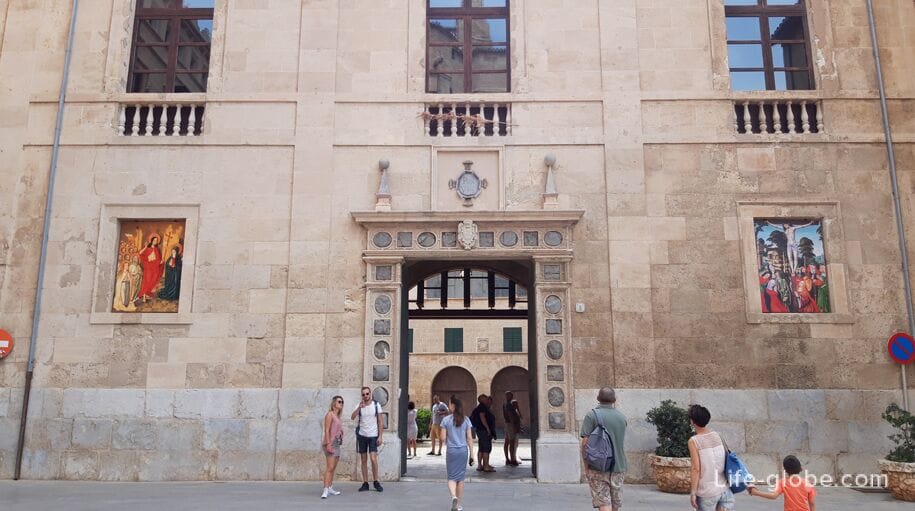
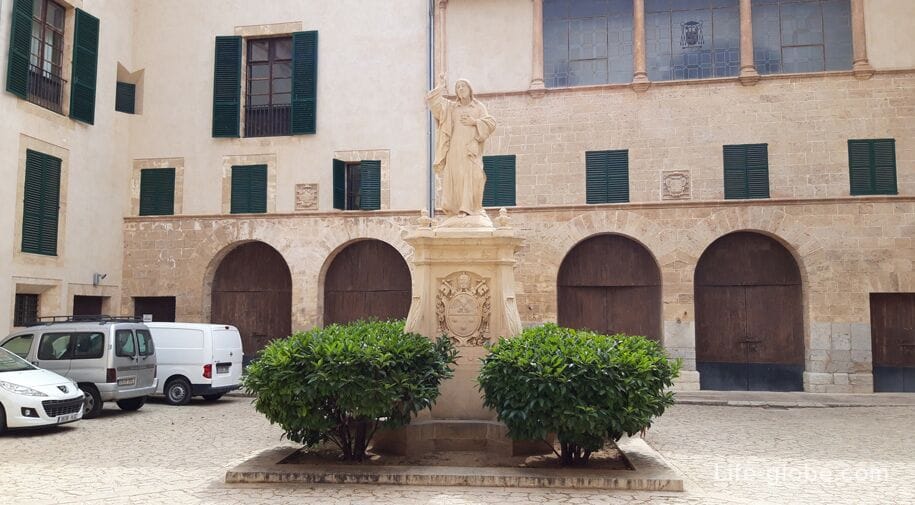
The exterior wall of the bishop's palace is attributed to Antonio Gaudi.
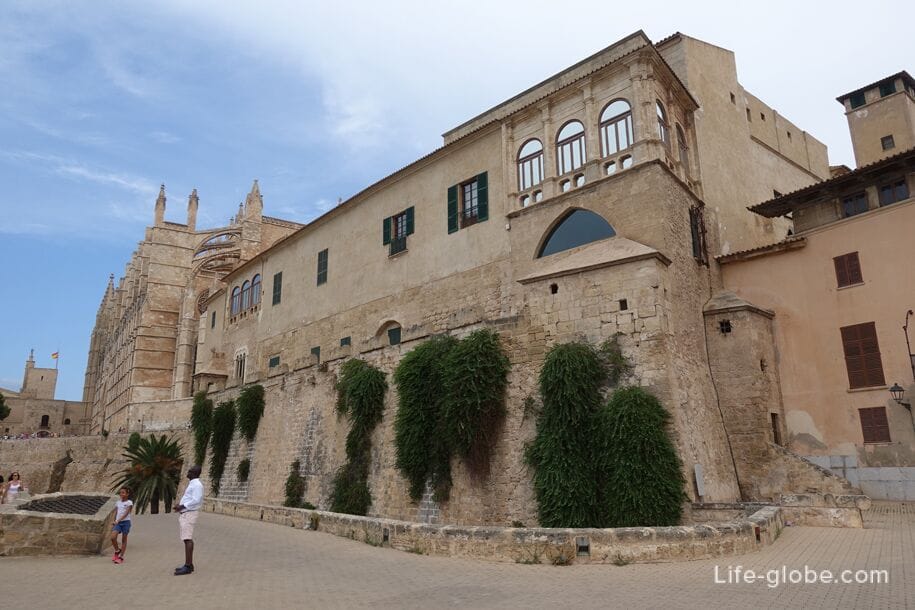
On the north side of the Bishop's Palace adjoins the Bishop's Garden or Bishop's Garden (Spanish: Jardin del Obispo, Catalan - Jardi del Bisbe, del Bisbe), which preserves the classical distribution of the gardens of majestic Palm houses, with areas for fruit trees, vegetables and decorative area.
In the park: places to relax, flowers and fruit trees, a decorative area and a small pool with fish.
Entrance to the garden is free (free of charge).
Garden address: Carrer de Sant Pere Nolasc, 6. More about the Bishop's garden...

The Museum of Mallorca (Museu de Mallorca) is a state-owned and located in a building (the house of Can Aiamans or Ca la Gran Cristiana, built in 1634), which was acquired by the City Council of Palma in 1971 and transferred it to the state to house the Museum of Mallorca.
The house retains most of the pentagonal structure of the Baroque period, which has only been altered by modifications made during the 19th century, although Gothic traces are still visible.
Museum address: Calle de la Portella, 5.
Museum website: museudemallorca.
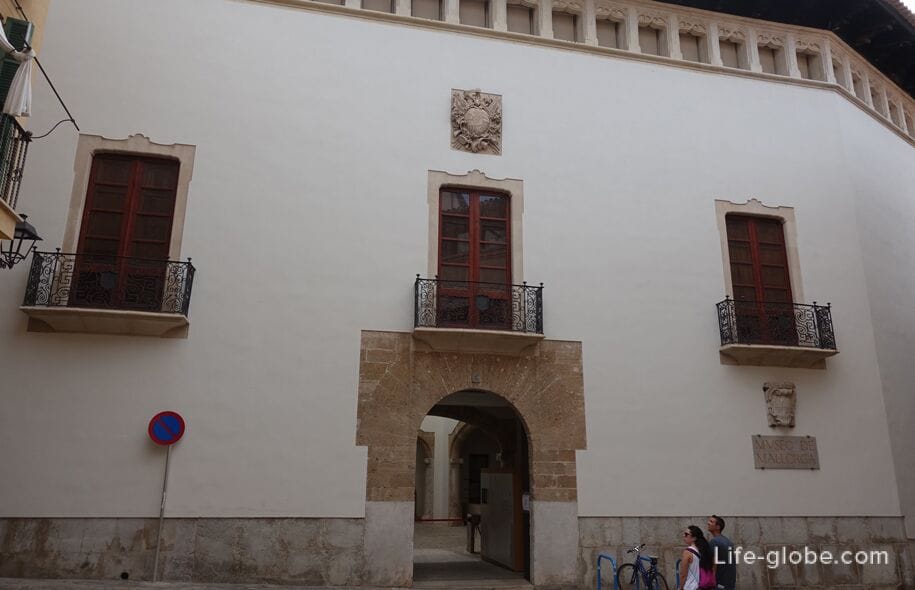
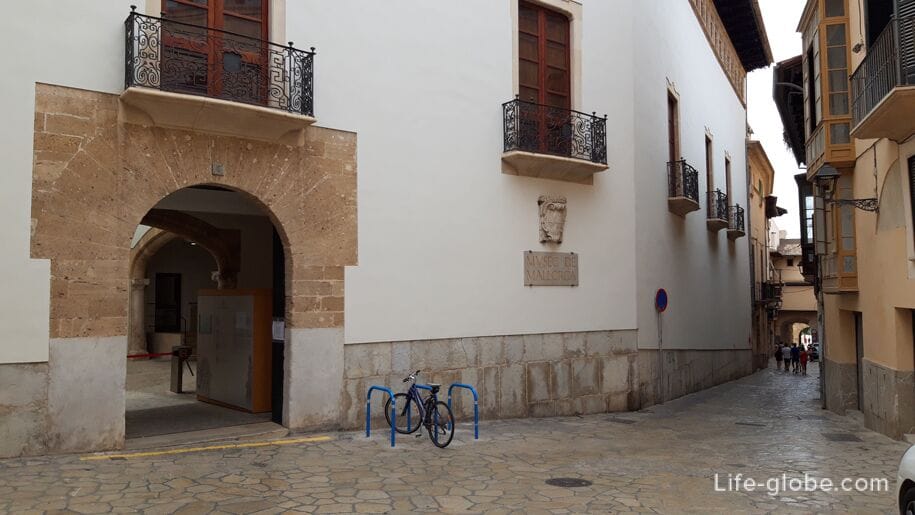
The Arab baths in Palma (Banys arabs de Palma / Arabic baths Palma) are one of the most ancient and symbolic historical monuments in Majorca.
Arab baths are one of the few examples of Muslim architecture on the island and the only baths of this kind in Palma, although it is known that initially there were more baths - at least five.
Only a part of the baths has survived to this day, which is a small structure with several entrances and internal rooms, including a room intended for taking hot baths - the so-called Caldarium.
The Arab baths are a museum. Entrance is paid.
The address of the Arab baths: Carrer de Can Serra, 7. Learn more about Arab baths...
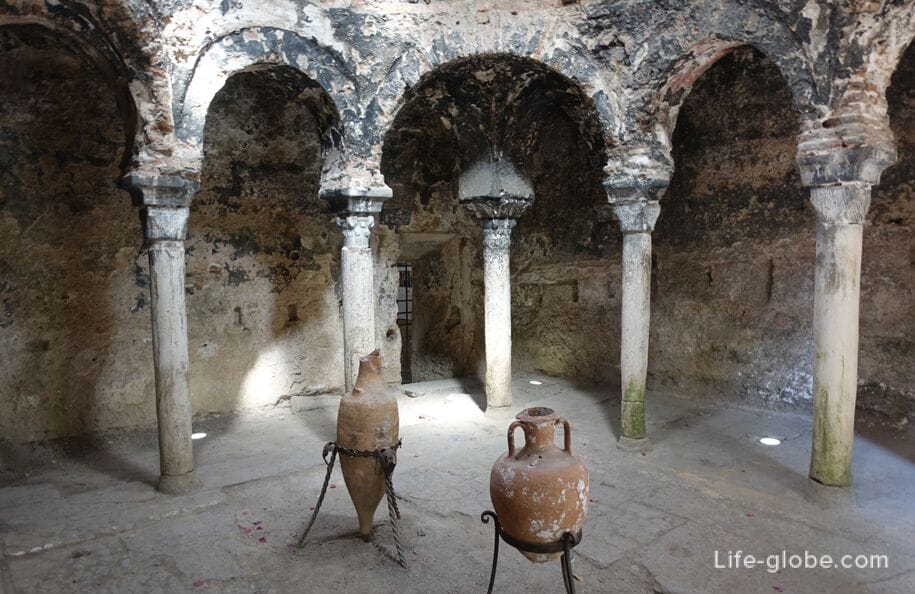
The Arab baths are one of the small monuments that have remained from the Muslim world in Palma. The second is the arch on Almudena Street (Carrer de l'Almudaina).

The Convent of St. Clara (Convent de Santa Clara) is a historical active convent, the first mention of which dates back to the 13th century and dates back to the reign of King Jaime I of Aragon.
The main building of the monastery was erected on the remains of a Muslim shrine. Over the centuries, the monastery was transformed and expanded, including the nearby civil buildings.
Today the monastery is a complex of buildings, the central place among which is occupied by the Church of Santa Clara with a square bell tower and the main portal (entrance), dating from 1671 and decorated with floral motifs.
Address of the monastery: Carrer de Can Fonollar, 2. More about Santa Clara Monastery...
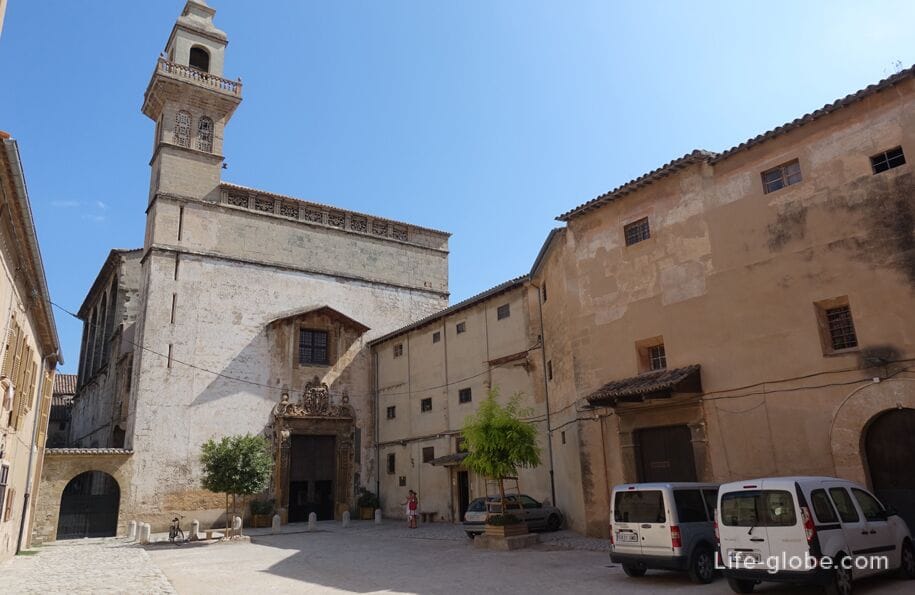
Paseo Sagrera (Paseo Sagrera, Catalan name: Passeig Sagrera) is a street running along part of the seaside boulevard Paseo Maritimo and having a length of 500 meters. The street stretches from Antonio Maura Avenue (Av. d'Antoni Maura) to the Riera Creek.
Paseo Sagrera is one of the most picturesque streets of Palma.
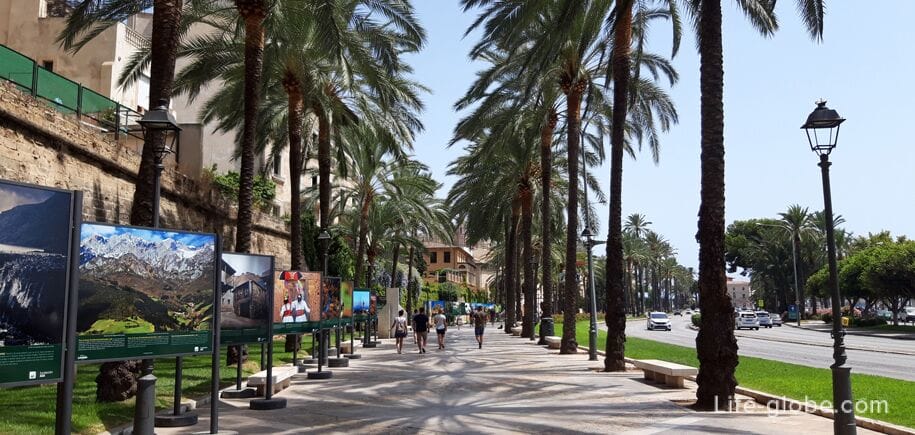
On the street, the building of La Lonja or "Palma Market" (La Lonja de Palma de Mallorca or Sa Llotja) is notable, which is one of the masterpieces of Gothic architecture in Majorca.
The building was built between 1426 and 1448 by the architect and sculptor Guillermo Sagrera (hence the name of the street) as the headquarters of the Board of Trade.
The plan of the building is rectangular, with one main interior space divided into twelve sections by peculiar columns.
The exterior of the building is decorated with towers with battlements and small sculptures, has arched windows and doors.
Currently, the building opens its doors only during exhibitions and cultural events.
Address of La Lonja: Placa de la Llotja, 5.
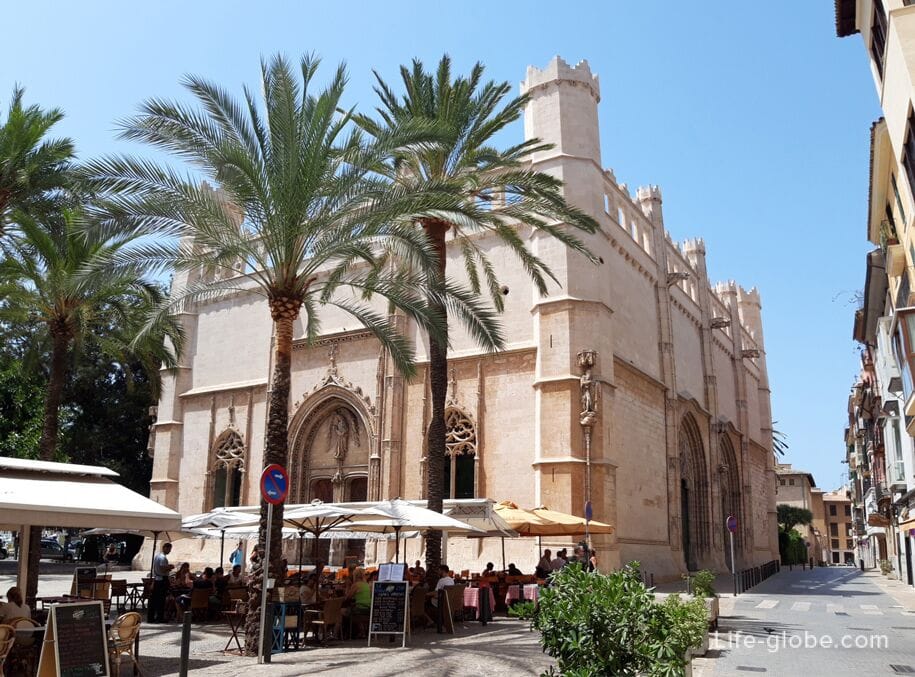
Another notable building along the street is Consulate of the Sea (Consulado del Mar), made in the style of Mannerism and built in 1669.
Initially, it was the place of the legal and commercial institute of the same name. Since 1983, it has been the seat of the Government of the Balearic Islands.
The unique architecture of the building clearly emphasizes the facade divided into three tiers (floors). The exterior of the building is also notable for the clock tower located on the eastern side of the building.
There are works of art in the consulate. There are also offices and work spaces where a team of people is working on the implementation of a general government project.
Sometimes, during public events, the building opens its doors to the general public.
Address Consulates of the Sea: Passeig de Sagrera, 7 / Carrer de la Llotja, 3.
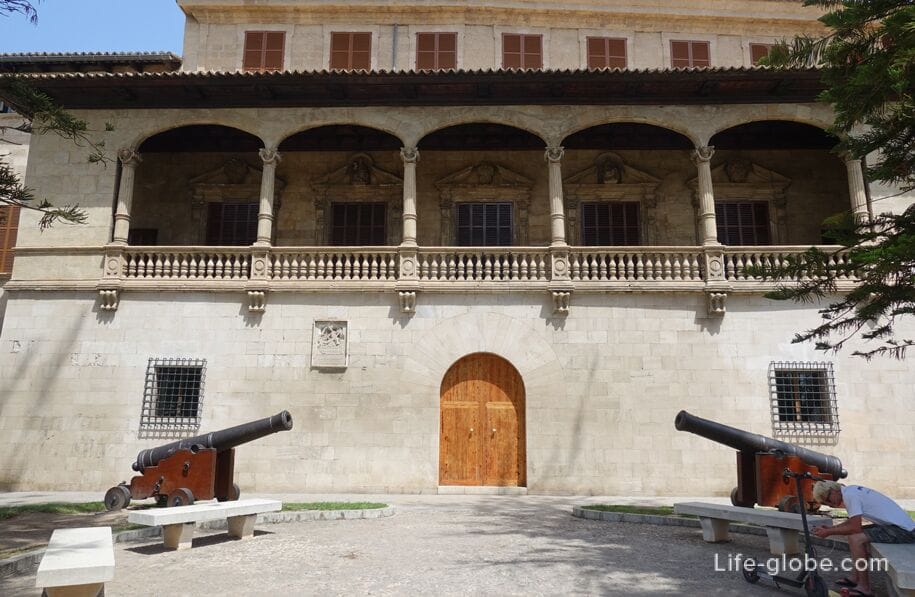
The Paseo Sagrera is also notable for the oldThe port gate, which was originally one of the gates of the old city walls of Palma.
The gate was the entrance to the city; it was located next to the old pier (hence the name of the gate) and was the main access to the city from the sea.
When the walls were demolished (1902), and the space near the sea was expanded, the gate was moved to its current location.
To date, only the entrance arch has been preserved from the gate. Learn more about Paseo Sagrera Street and all its attractions...
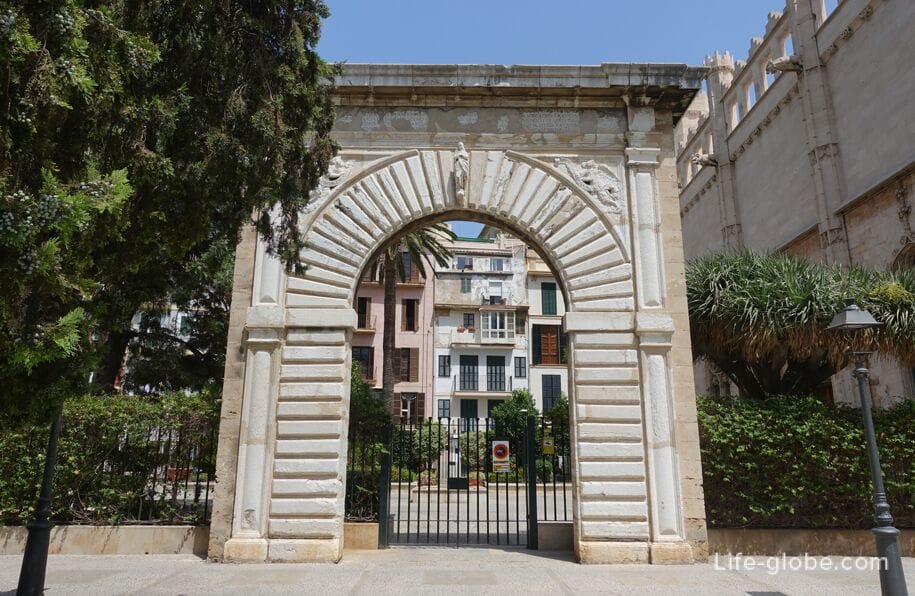
The Es Balouard structure was formerly the bastion of San Pedro (Bastion of San Pere or Bastion of St. Peter / Bastio de Sant Pere), which, in turn, was part of the old Renaissance wall of the city.
The bastion was built between 1575 and 1578 in order to strengthen the old defensive wall of the city and was a walled protection and observation building.
Now the former bastion houses the Es Baluard Museum of Modern Art (Es Baluard).
Also in the old bastion there is a panoramic terrace and a restaurant.
The terrace and outdoor areas, as well as the museum premises on some days, can be viewed free of charge.
Es Balouard address: Plaza Porta de Santa Catalina, 10.
Museum website: esbaluard. More about the Es-Balouard Museum...
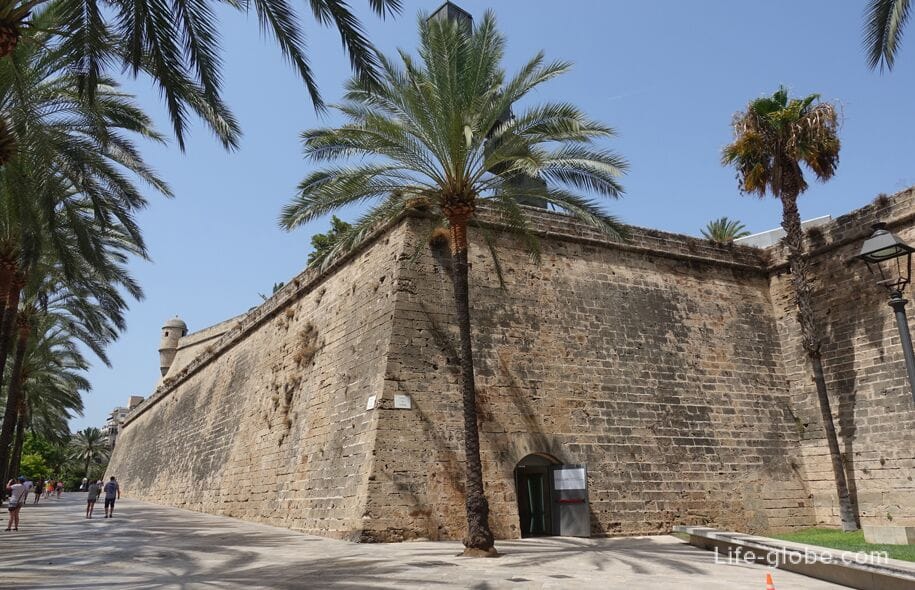
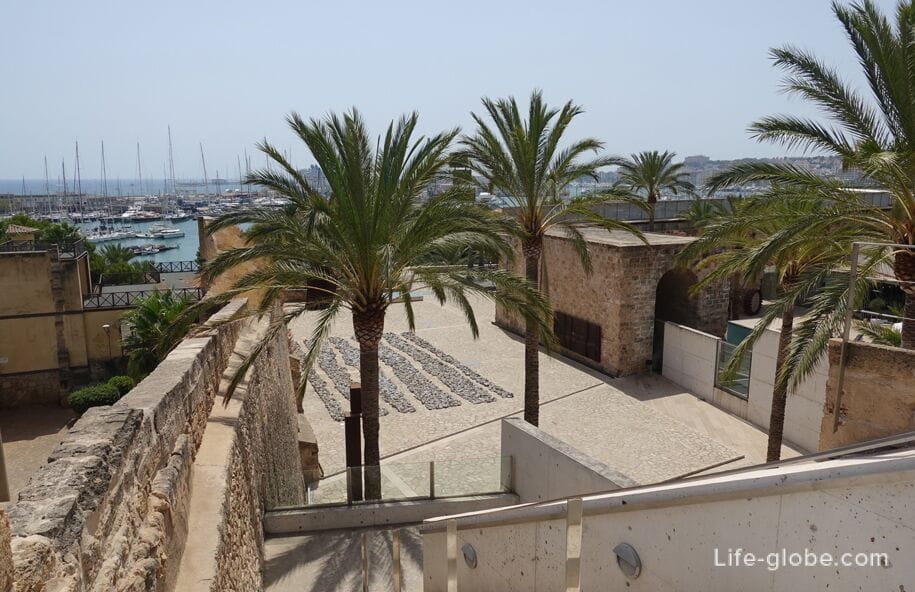
Behind Es Balouard is the area of the Port of St. Catalina (Plaza Porta de Santa Catalina), from which the church of Santa Cruz (Parroquia de Santa Cruz), made in Neo-Gothic style with a square bell tower with a height of 60 meters, is clearly visible.
Temple website: parroquiadesantacruz.
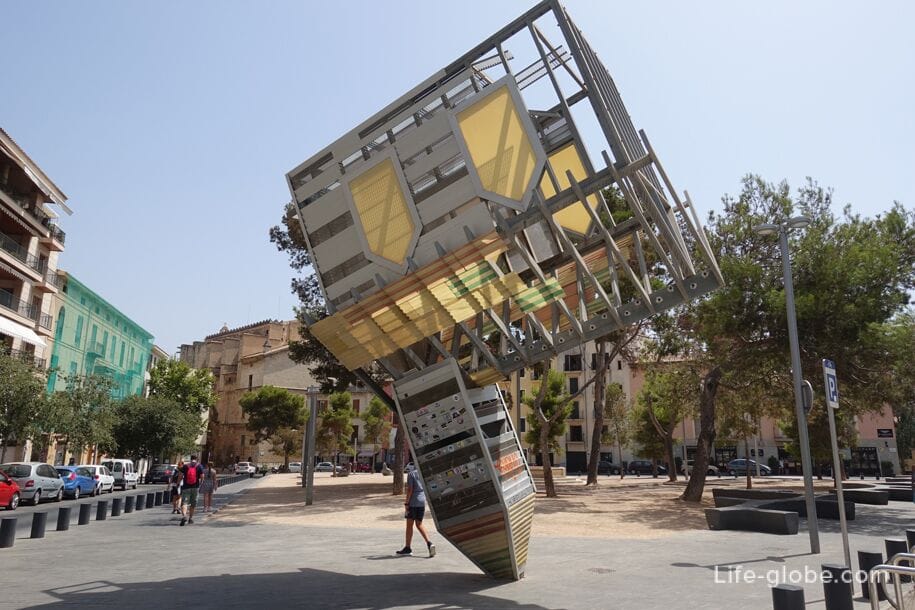
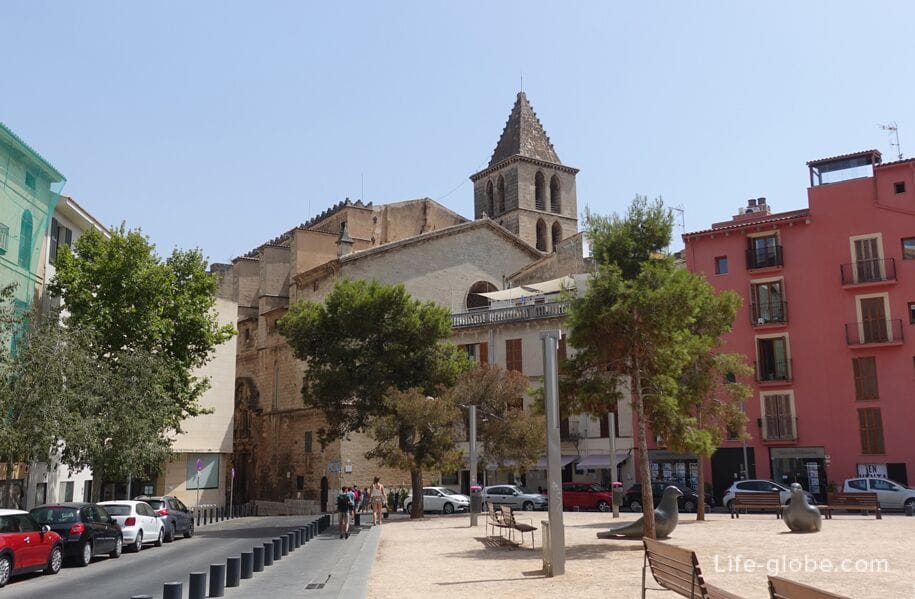
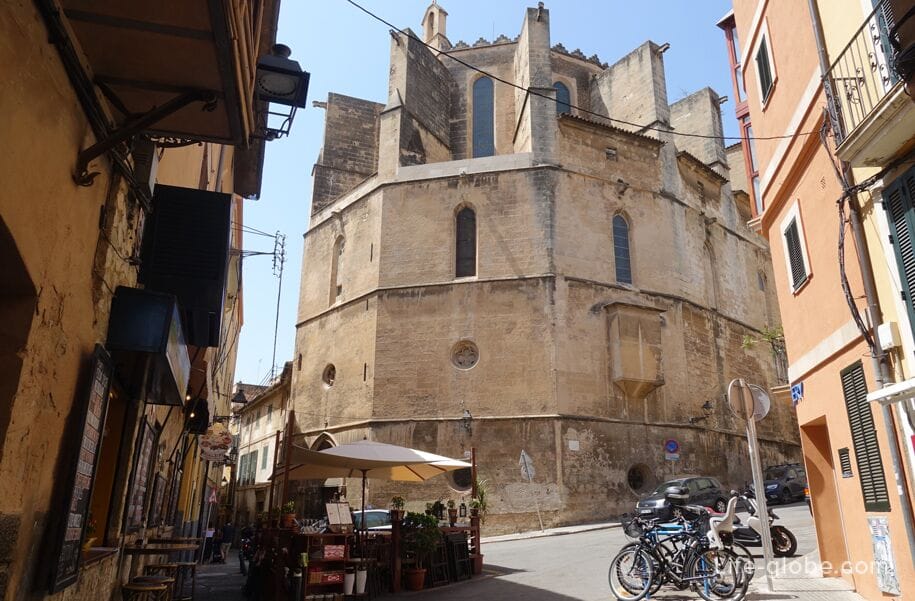
The Basilica of St. Francis (Basílica de Sant Francesc) has a 13th-century facade that was renovated after a lightning strike in the 17th century.
The basilica is made in a typical Majorcan style, with a huge sandstone wall and fine carvings with a rose window in the center. The basilica complex includes an inner courtyard.
Inside the church is the tomb of Ramon Lulli (1235-1316), who became a hermit after an unsuccessful seduction trip, and who was stoned to death after he tried to convert Muslims in Tunisia.
Near the basilica there is a statue of another famous major missionary, Fra Junipero Serra, who lived in the city monastery.
Entrance to the basilica complex is paid (5 euros).
The address of the basilica: Plaça de Sant Francesc, 7.
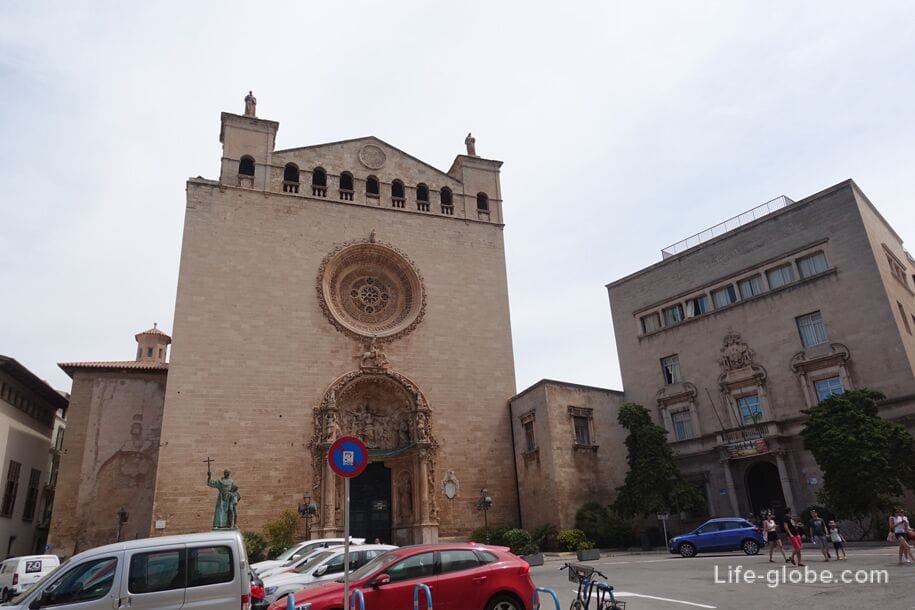

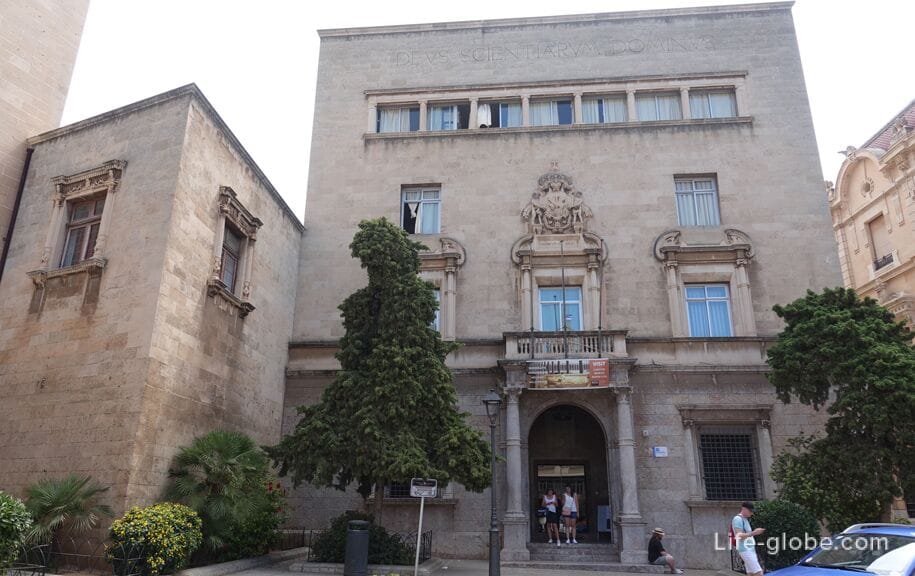
The House of Barcelo (Can Barcelo) is one of the pearls of the Art Nouveau style in Palma and dates back to 1902.
The facade of the building stands out with mosaic tiles and carved glazed balconies.
Building address: Plaça de Quadrado, 9.
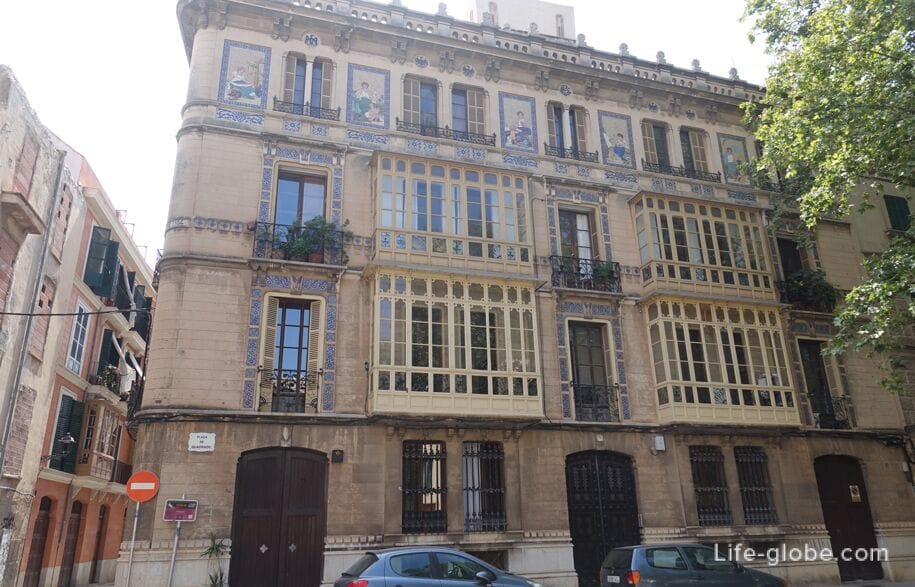
The Church of St. Eulalia, may be known as the Church of St. Eulalia (Santa Eulalia Church, Spanish name: Iglesia de Santa Eulalia) is an important and one of the oldest Catholic churches in the city.
The history of the church dates back to the 13th century.
With the exception of the tall and characteristic Neo-Gothic bell tower, built in the middle of the 19th century, the church is a Gothic building.
The interior of the church is notable for the Baroque altar by Alberto de Burguni, as well as side chapels and paintings from the 15th century.
Church address: Placa de Santa Eulalia, 2. More about the Church of Eulalia...
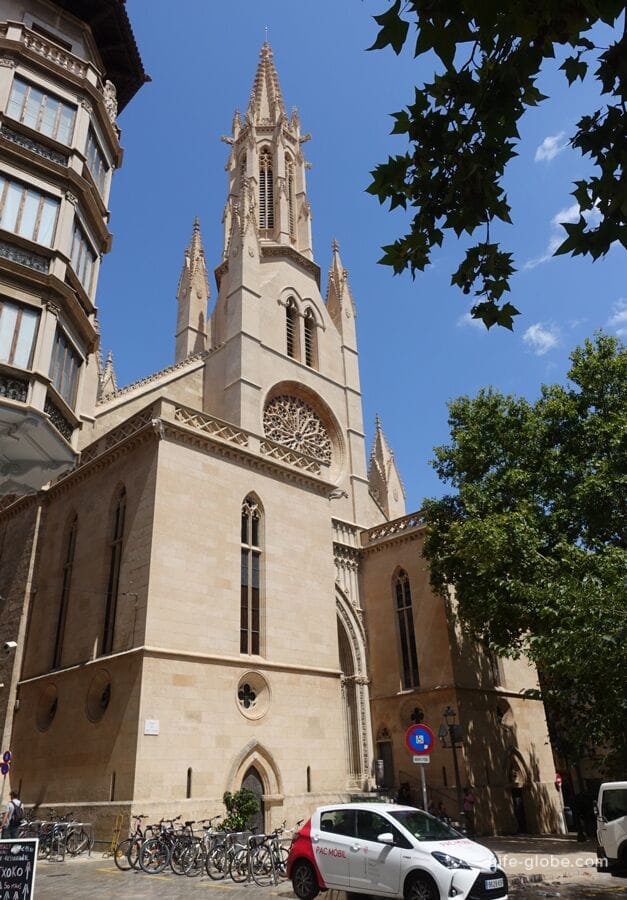

The Town Hall of the city of Palma de Mallorca or the Mayor's Office of Palma (the building of the City Council of Palma - Ayuntamiento de Palma de Mallorca, Catalan name: Ajuntament de Palma) is located on one of the central and busiest squares of the city - Plaza de Cort.
The three-storey town hall building has a Baroque facade with elements of Gothic and Mannerism - a traditional major style. It was built between 1649 and 1680 by architects Pere Baucha, Michele Oliver and Bartomeu Calafat.
A visit to the town hall is possible.
Address of the Town Hall: Plaça de Cort, 1. Learn more about the Palma Town Hall and its visit...
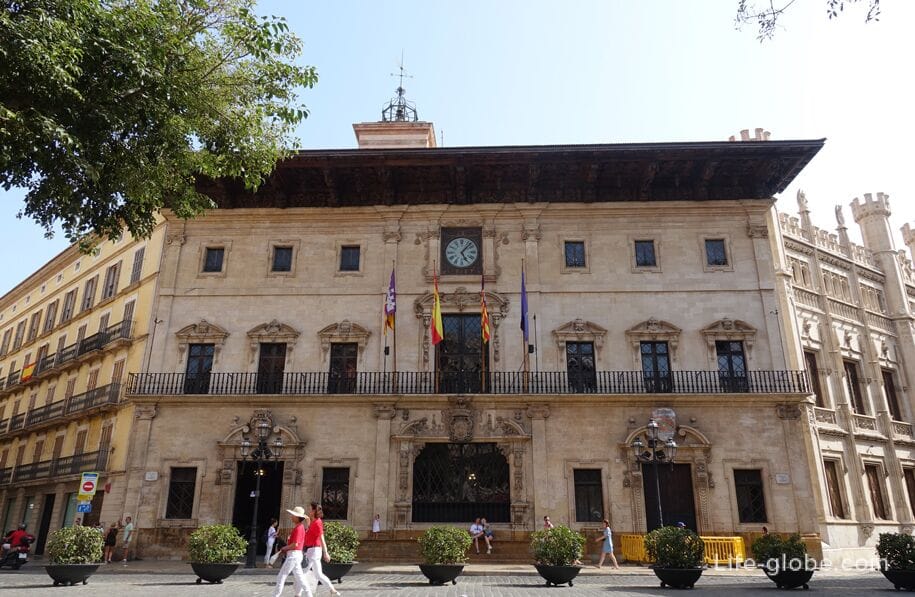
Cor t Square, where the Town hall of Palma is located, is a very popular place in the city.
Around the square there are historical buildings with bright facades, on the ground floors of some of which there are cafes and restaurants with tables in the open air.
The center of the square is decorated with a large old olive tree, which was transplanted to the square on May 3, 1989. Learn more about the Court Square...
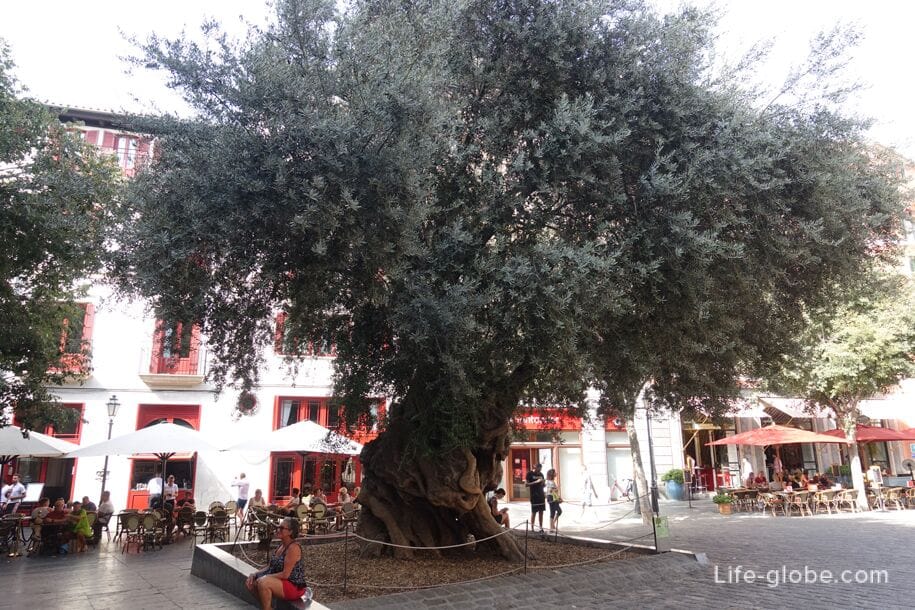
The Palace of the Council of Mallorca (Palau del Consell), which attracts attention with its Neo-Gothic facade with four towers, adjoins the City Hall of Palma from the Royal Palace Street (Carrer del Palau Reial).
The building was built to house the old provincial council. The construction was carried out by architect Joaquin Pavius between the 19th and 20th centuries, and meant a complete reconstruction of the building of the old city prison (1230-1870).
The lobby of the building, which can be visited, is distinguished by a grand staircase leading to the second floor, where a gallery and a meeting room with a great wealth of ornaments are located.
The address of the council building: Carrer del Palau Reial, 1. More about the Majorca Council Palace...

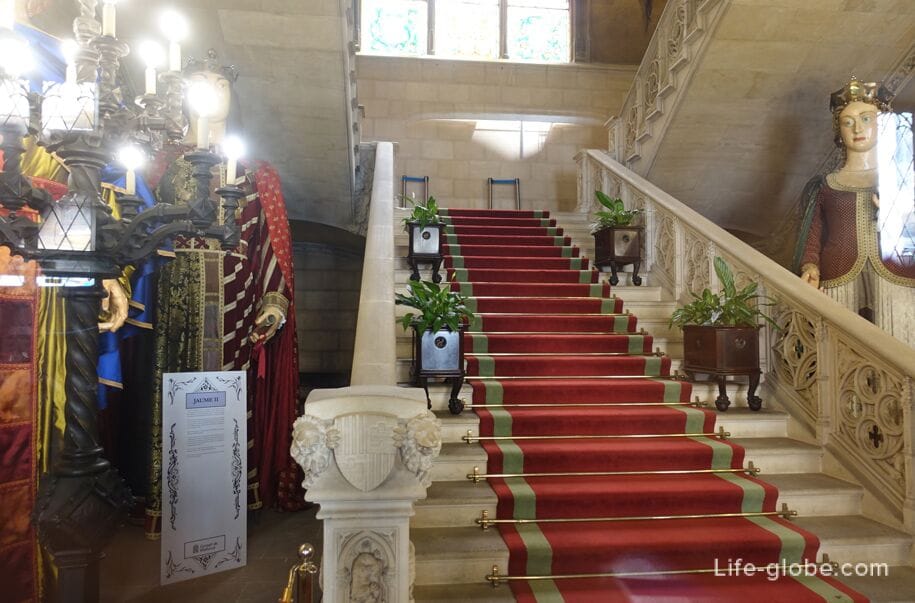
The Marquis Palmer Square (Placa del Marques del Palmer) is a small square that, towards the sea (to the south), smoothly flows into the street of Colom (Carrer de Colom), which, in turn, is one of the most visited streets of the city. Learn more about the square and the street...


The most outstanding and beautiful buildings of the square are: House Kahn Forteza Rey and the Edificio El Aguila, which are architectural monuments and were erected in 1908-1909.
Since the buildings are located nearby, they are visually perceived as a single architectural ensemble of the modernist style. Facades of buildings are distinguished by abundant sculptural decorations, windows and balconies. More about the buildings of Can Forteza Rey and El Aguila...

The Can Corbell building, may be known as Can Corbella (Building Can Corbella) is one of the most original buildings of the historical center of Palma.
Can Corbella is located on the corner of the Court Square and St. Domingo Street (Carrer de Sant Domingo).
The building has 5 floors and a tower. It was built by architect Nikola Literes at the end of the 19th century by order of the rich and famous Corbell family at that time.
The architecture of the house is made in the so-called neo-Mudejar style (Spanish-Moorish style or Moorish Revival style), in which a mixture of Arabic elements and Christian ornaments are visible. More about the building and the street...
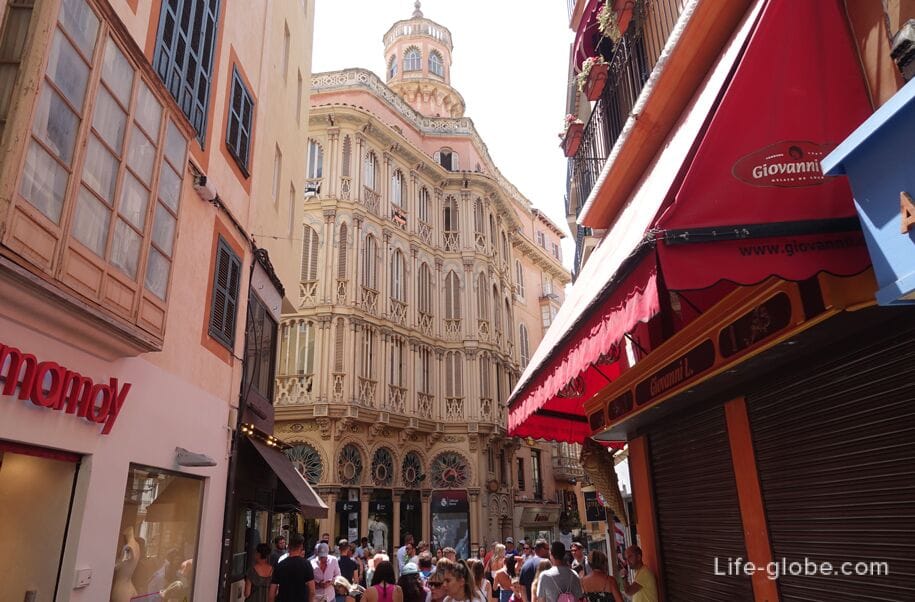
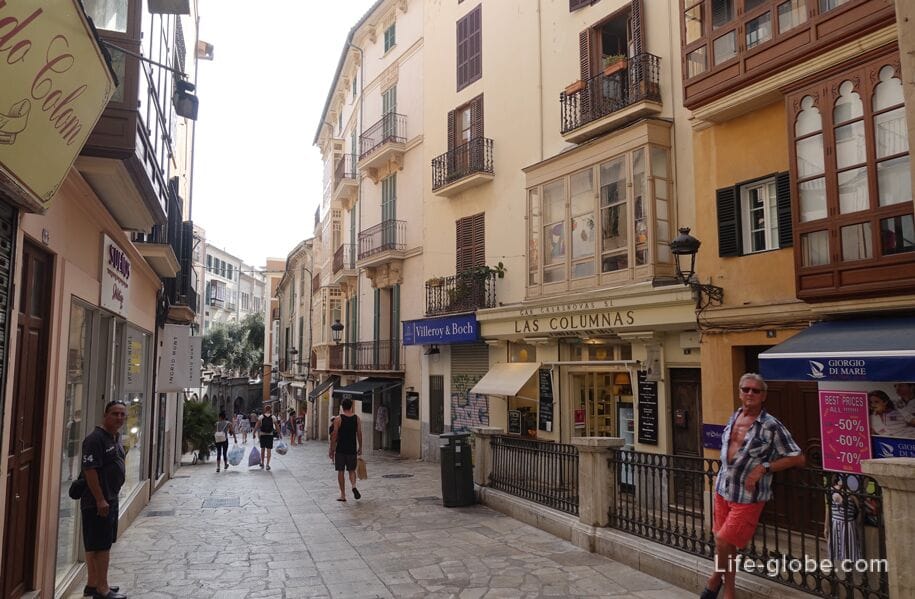
Plaza Mayor (Catalan name: Plaça Major), which means "big square" is the main and one of the most visited squares of the city of Palma de Mallorca.
The square has a rectangular shape. Along the perimeter of the square there are 3- and 4-storey buildings with porticos on the ground floors - covered galleries supported by columns. Thanks to these buildings, the square forms an enclosed space. Through the covered galleries (passageways) you can access the neighboring streets.
Cafes, restaurants and shops are located on the ground floors of the square buildings. On the square itself, the public is entertained by street performers, and underground parking and shopping galleries are located under the square. More about the Major Square...
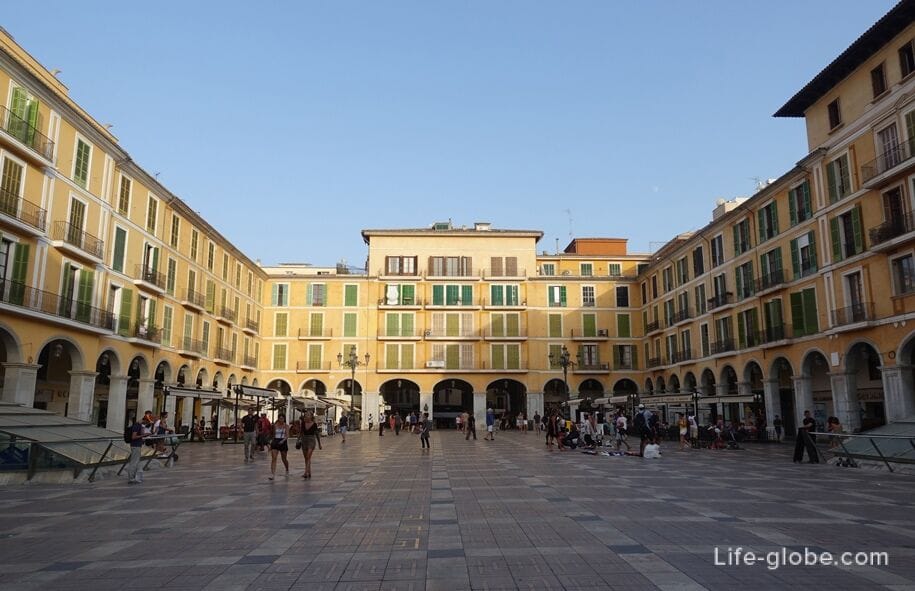
San Miguel Street or Sant Miguel Street / St. Michael Street (Carrer de Sant Miquel) is one of the most important shopping, as well as the most visited streets of the historical center of Palma.
The length of St. Michael's Street is about 600 meters. It stretches north from the Mayor Square, to the northern edge of the city center - the intersection of the streets Joan March (Avenida Joan March Ordinas) and Comte de Sallent (Avinguda del Comte de Sallent).
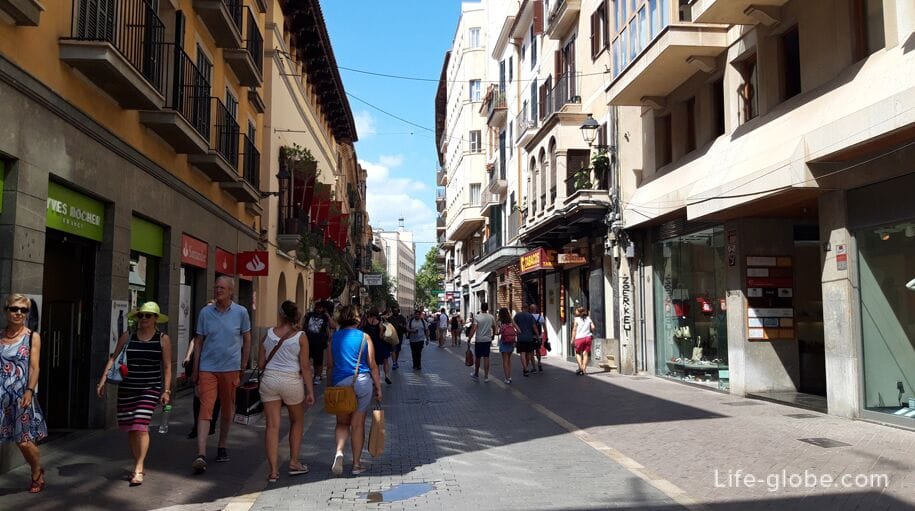
The street is notable: the Museum of the Juan March Foundation (Museu Fundacion Juan March), located in a historic building of the 17th century; St. Michael Basilica (Basilica of St. Michael) on behalf of which have received the name of the whole street; the old convent of San Antonio (Convent Sant Antoniet) with a small parish Church; and the Church of the parish of Santa Catalina de Siena (Esglesia de Santa Catalina de Siena), the Church of St. Margaret (Esglesia de Santa Margalida) and the center of military history and culture of the Balearic Islands (Centro de Historia y Cultura Militar de Baleares), which hold exhibitions and conferences. More about San Miguel Street...
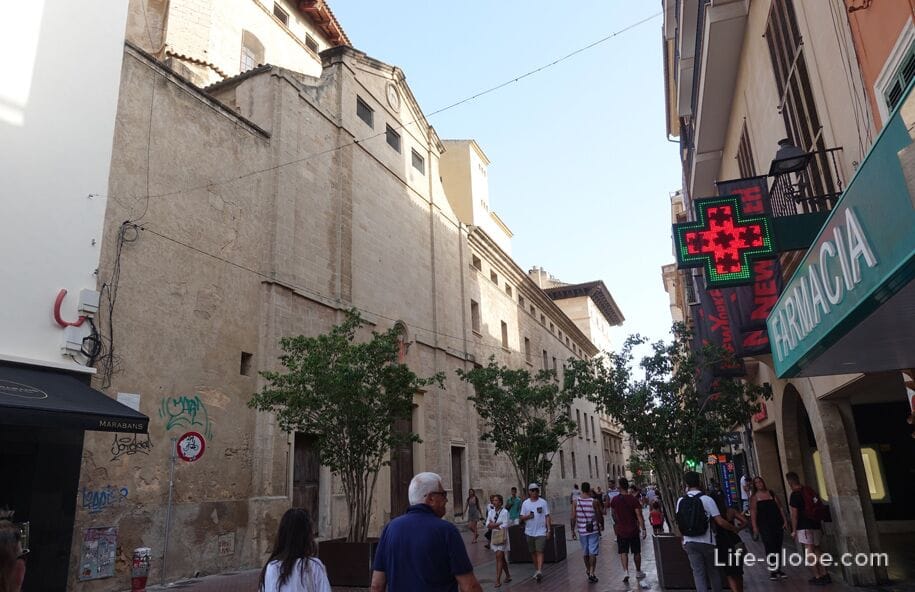

The Market Square (Plaça del Mercat) attracts attention with some sights, as well as the atmosphere of lively, and at the same time somewhat relaxed life of Spanish island cities.
The center of the square is decorated with a sculpture installed in honor of Antonio Maura y Montaner (1853-1925), president of the Spanish government.
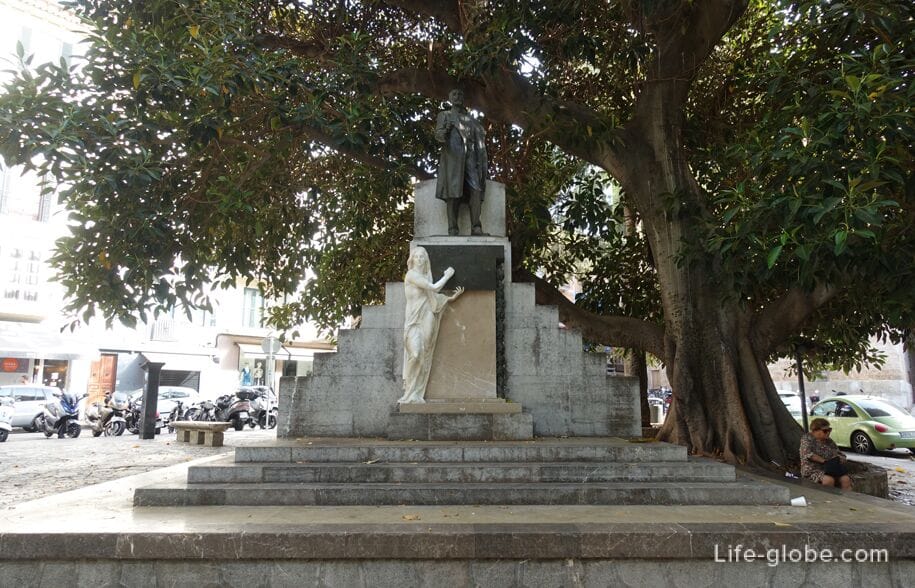
Notable on Merkat Square are:
- the Church of St. Nicholas (Esglesia de Sant Nicolau), the first building of which was the parish church of 1302.
The church stands out with a high stepped bell tower of hexagonal layout. More about the Church of St. Nicholas...
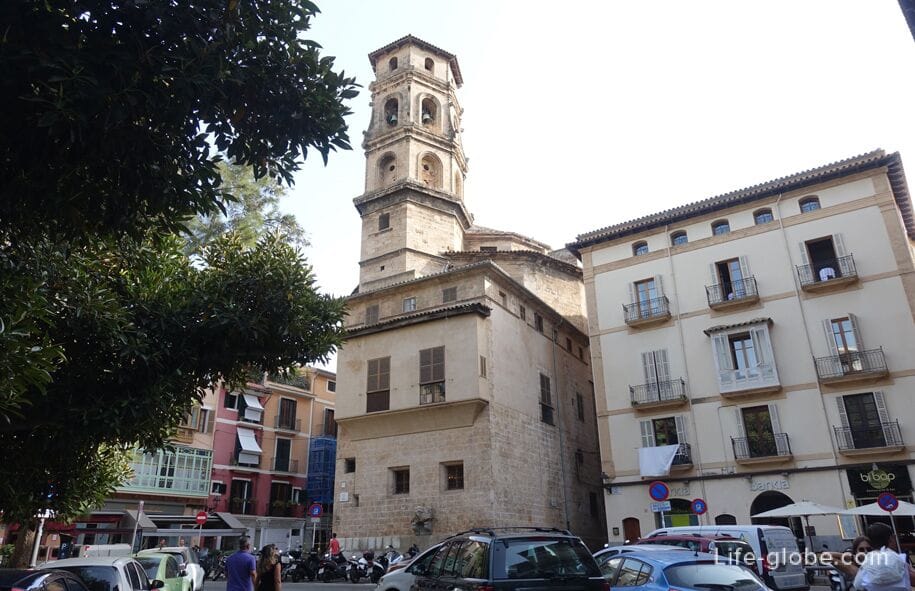
- the "Twin" buildings are two externally almost identical buildings: the Casasayas House (Can Casasayas / Edifici Casasayas) and the Menorguina building (Pensión Menorquina), erected in 1908-1911.
The buildings are notable for the wave-shaped facades, parabolic arches of windows and doorways. The first floors of the buildings are occupied by commercial premises;

- The historic building of the Supreme Court of the Balearic Islands or the Back of Justice (Tribunal Superior de Justicia de las Islas Baleares), which houses the highest judicial authority in the autonomous community of the Balearic Islands. Learn more about Merkat Square...
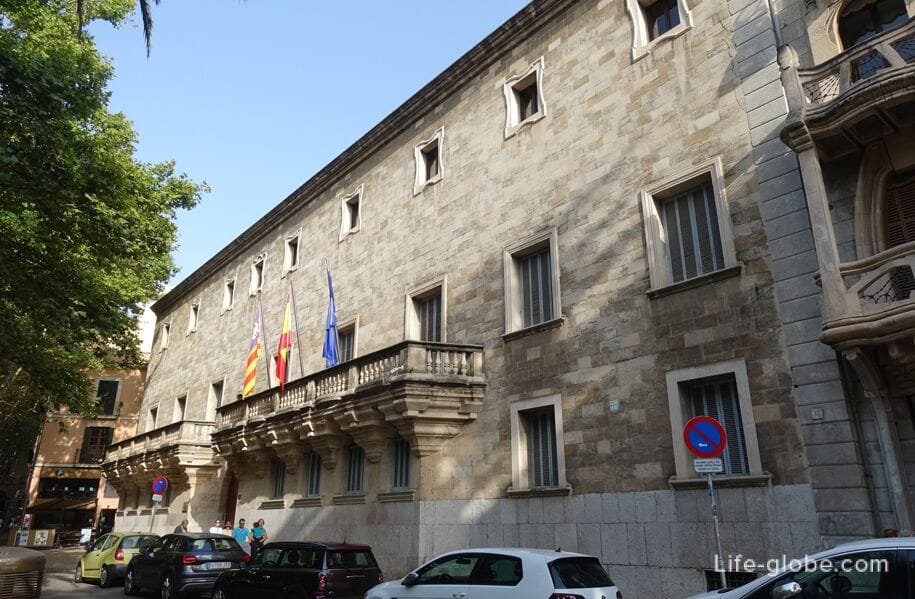
The Olivar Grocery Market (Mercat de l'Olivar) is the iconic and largest in Palma.
This is the central covered market, which also houses cafes, bars and a large Mercadona supermarket on the ground floor.
The Mediterranean-style market building was built in 1951 and was subsequently restored, which allowed the market to have a large hall.
The market has stalls with fruits and vegetables, fish and seafood, meat and poultry, cheeses and sausages, as well as a shopping gallery with non-food products.
Market address: Plaça de l'Olivar, 4.
Market website: mercatolivar.
Plaza de Espanya is located on the northern edge of the historic center of Palma and is one of the most important squares of the city.
The square is surrounded by trees and historic buildings, including the Convent of the Capuchins (Convent Frares Caputxins).
In the middle of the square in the center of the fountain there is an equestrian monument to Jaume I, the king of Aragon, Majorca and Valencia, the one who conquered the island from the Moors.
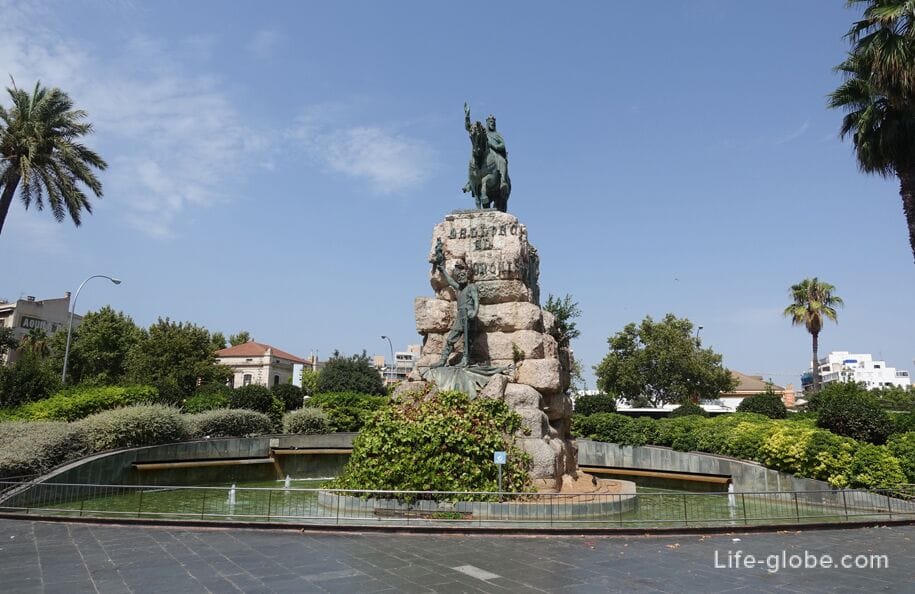
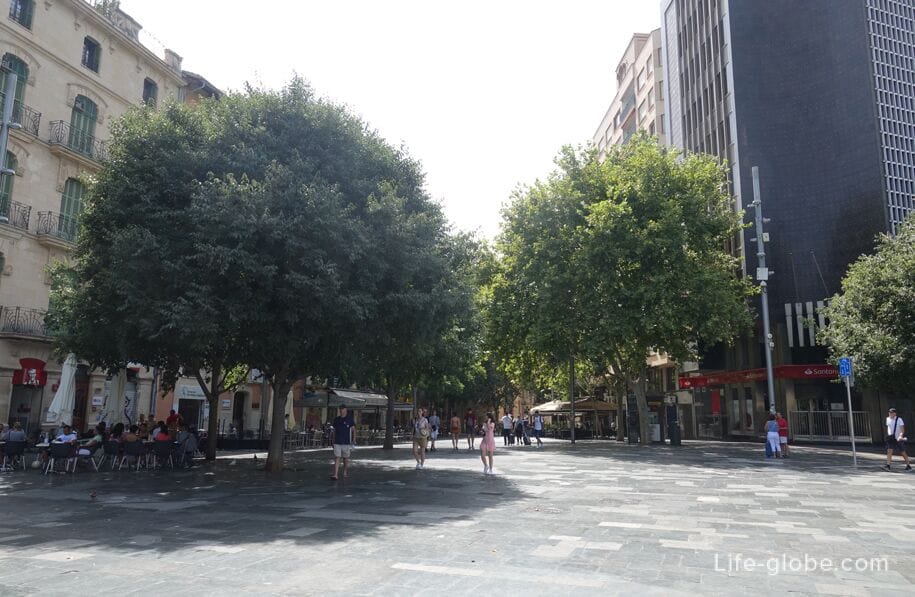
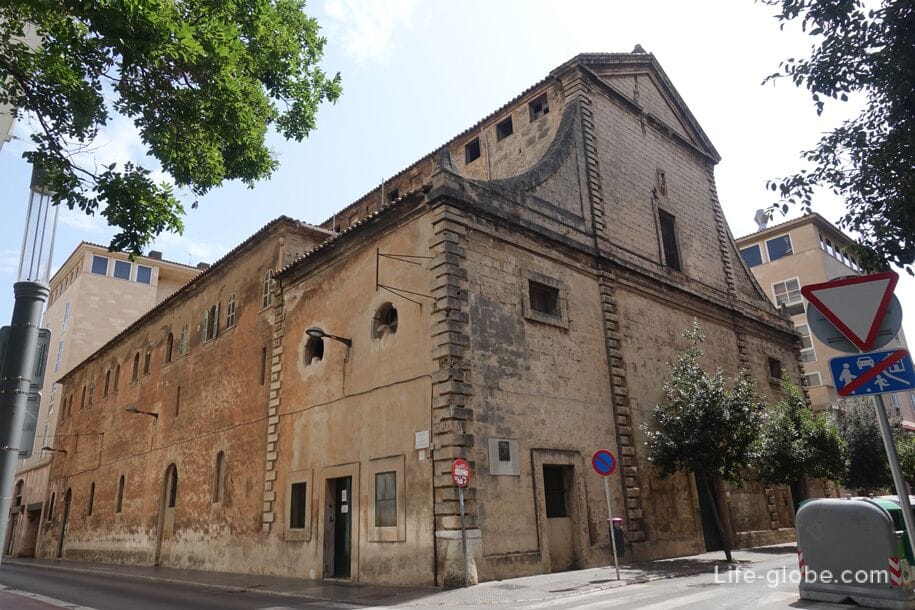
Opposite the Plaza de Espana is the city's bus station and the Ferrocarril de Soller railway station (address: Carrer d'Eusebi Estada, 1), from which historical trains depart and arrive in the beautiful city of Soller.
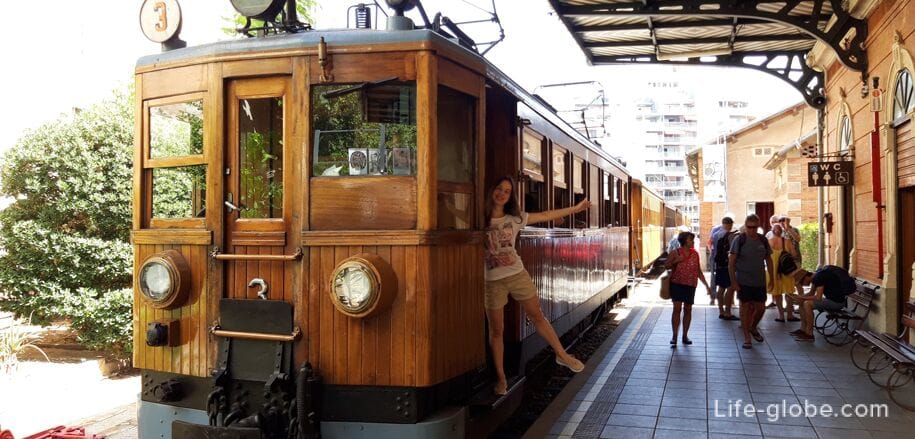
The Royal Square or Queen's Square, Plaza de la Reina (La Plaza de la Reina / Placa de la Reina) is one of the squares located in the lower part of the old town of Palma.
The center of the square is decorated with a fountain.
On the western side of the square there are historical buildings typical of the architecture of the center of Palma, and on the eastern side there is a small decorated green area with sculptures, a fountain and places to relax. More about the Royal Square...
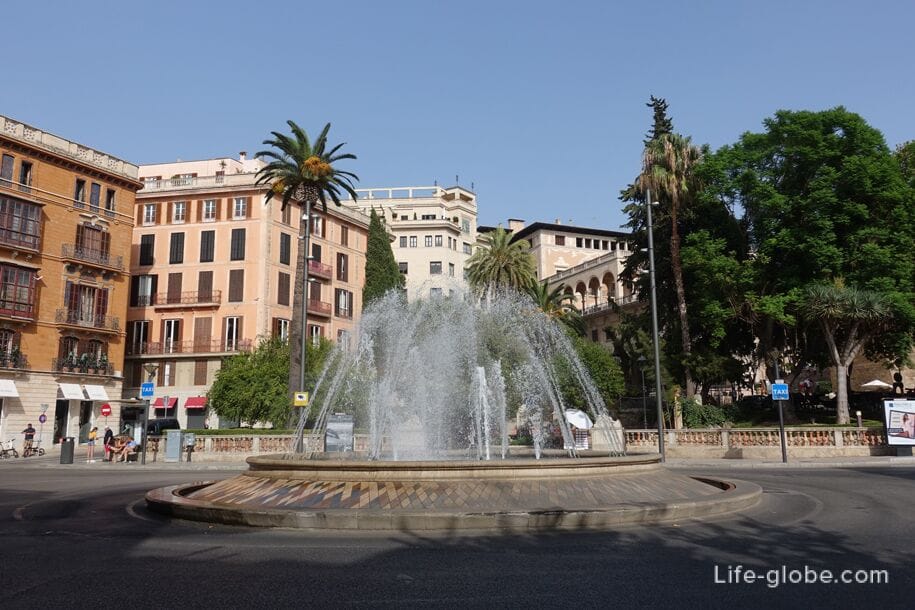
Boulevard Born or Paseo del Born (Passeig del Born) is a boulevard (street), which is one of the most visited and busiest streets of the historical center of Palma, as well as one of the most extensive boulevards of the city.
The boulevard consists of a central pedestrian part with shaded areas with seating areas, as well as two traffic lanes on each side of the pedestrian part of the boulevard (one for each direction), one of which is currently also a pedestrian zone.
Along both sides of the boulevard, historical buildings are lined up in a row, on the ground floors of which there are shops, boutiques, cafes and restaurants with open-air tables in the center of the boulevard.
Notable among the historical buildings along the boulevard are the old Born Cinema and the Casal Solleric Palace of the second half of the 18th century in Rococo style during the transition to neoclassicism.
From the side of the Royal Square, the boulevard is decorated with sculptures of sphinxes.
At the end of Born Boulevard is Juan Carlos I Square, notable for a fountain with a high obelisk consisting of two parts that are connected by sculptures of turtles. For this reason, the area is also called Turtle Square.
Near Juan Carlos I Square, Born Boulevard meets Jaime III Avenue (Av. de Jaume III), which is one of the main commercial streets of Palma. More about Born Boulevard...
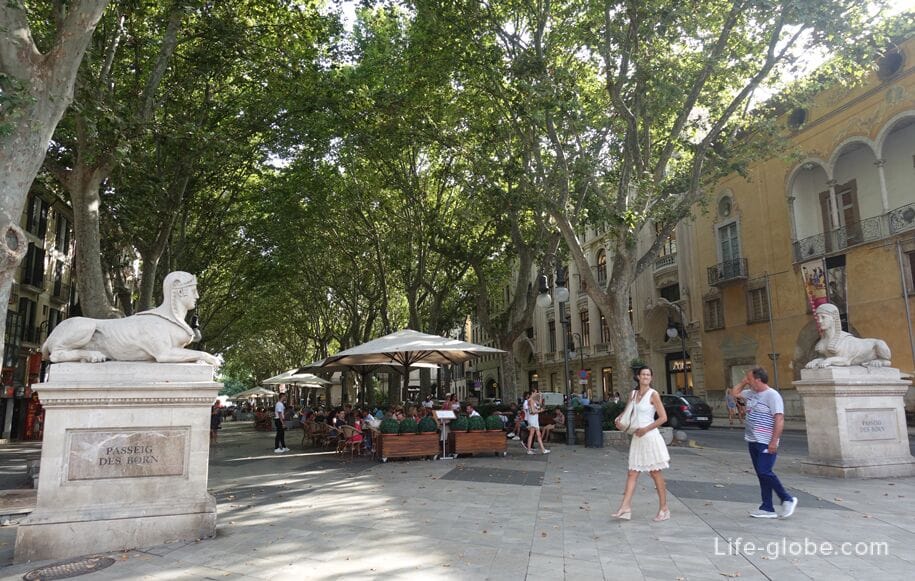

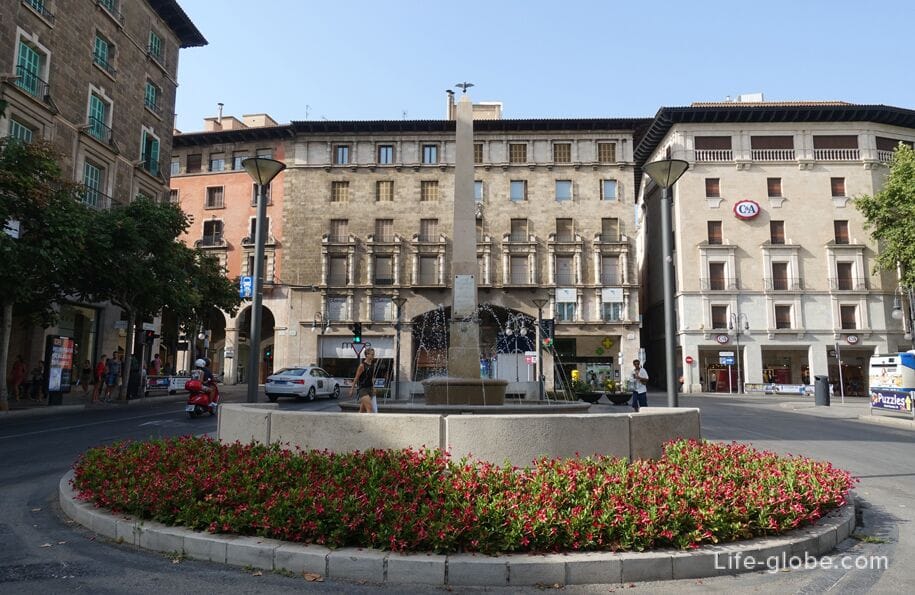
Can Balaguer or the house of the Marquis Reguer (Cal Marques del Reguer / Can Balaguer) is a historical building, also known as the House of Blanes (Can Blanes, La casa Possible).
The history of the house dates back to the 16th century.
The house has a remarkable courtyard, and going up to the second floor, you can get into the interior of the house, which consists of an interweaving of rooms and a corridor, including an entrance hall, a bedroom, a fireplace and a dining room, decorated in the style of the 19th - early 20th centuries, including furniture and household items.
The house also has three rooms (spaces) that are related to Josepe Balaguer (a musician living in the house in the 20th century): an art gallery, a music room and a Louis XV room.
Address of the house: Carrer de la Unio, 3. More about the Balaguer House...

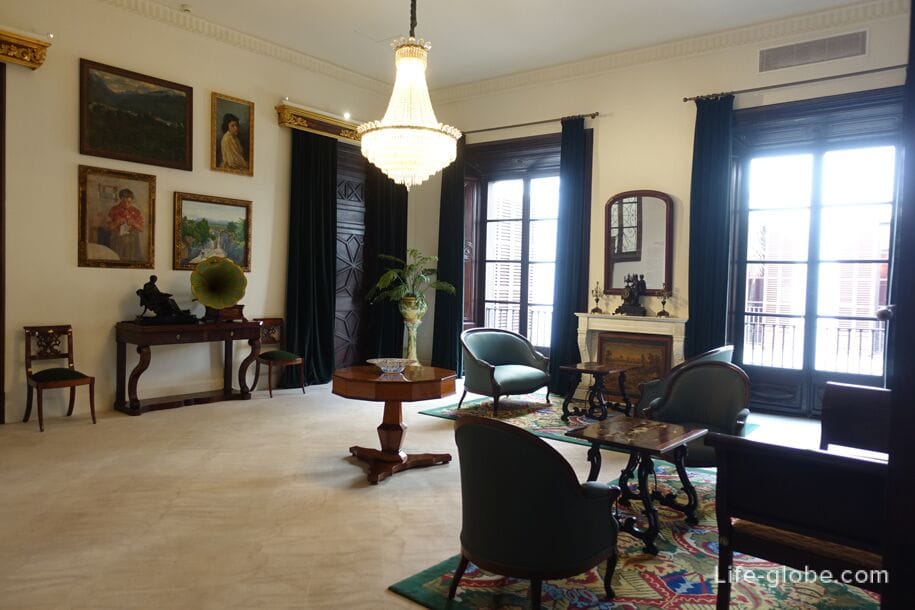
The Grand Hotel building is one of the most striking and important examples of modernism on the island of Majorca.
The hotel was designed by architect Luis Domenech y Montaner in 1903. The facade of the building is richly decorated with sculptural elements and ceramics.
The building has been restored and today is a cultural center that contains a permanent exhibition of paintings by the Spanish artist Ermenehildo Anglada Camaras.
Address of the Grand Hotel: Placa de Weyler, 3. More about the Grand Hotel...
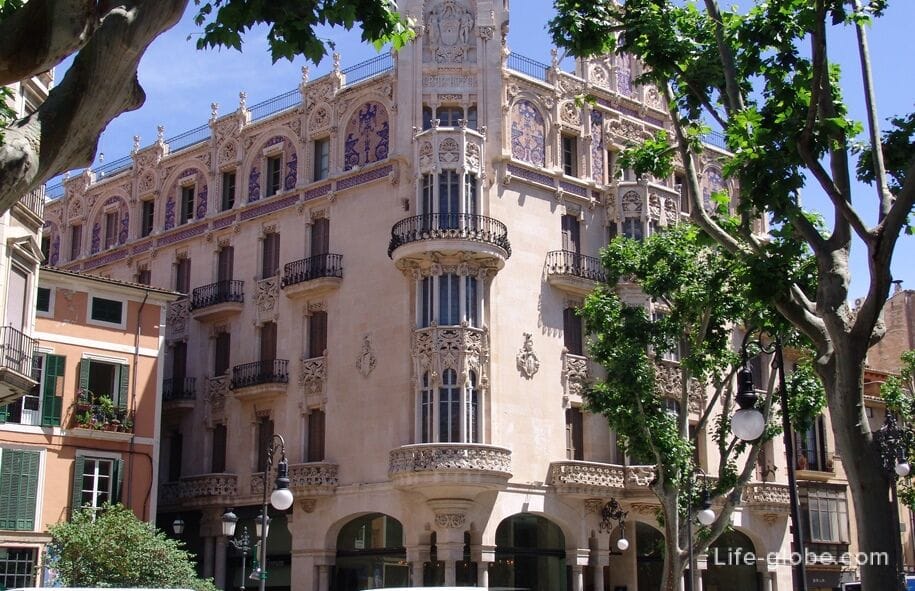
The Principal Theater or the main theater of Palma (Teatre Principal) was originally opened in 1667 under the name "Casa de les Comedias" and could accommodate 800 people.
The theater has a rich history, including it was destroyed by fire, but then restored according to the old plans. The scene has also been adapted and expanded.
Today it is also an active theater in Palma.
Theater address: Carrer de la Riera, 2.
Theater website: teatreprincipal. More about the Principal Theater...
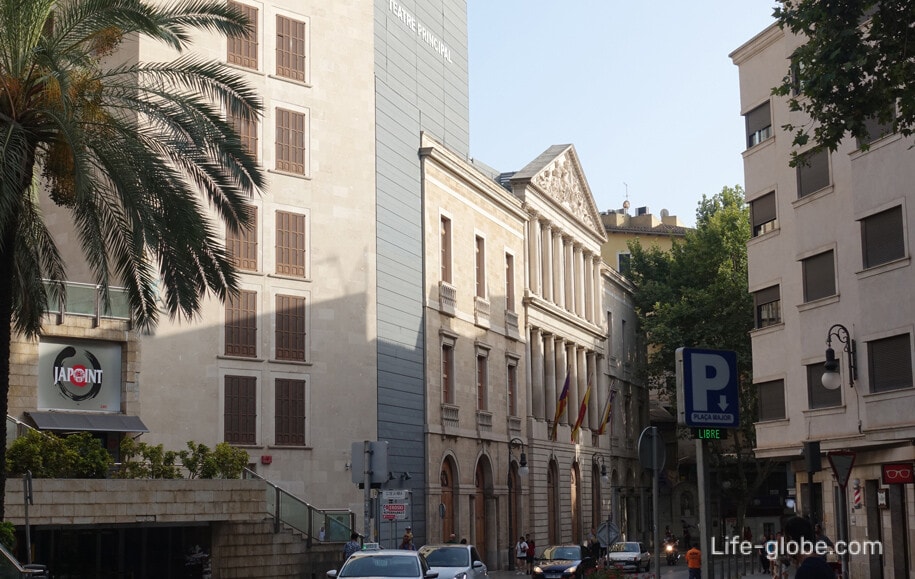
Boulevard La Rambla (La Rambla de Palma) is one of the streets in the historical center of the city, but not very busy and little-known among the guests of the city.
La Rambla consists of a central pedestrian zone, vehicle lanes and sidewalks on each side.
Plane trees grow along the perimeter of the central pedestrian zone of the street. There are places for recreation, kiosks that are under concession for the sale of plants and flowers, as well as a small fountain and sculpture. More about Rambla Boulevard...
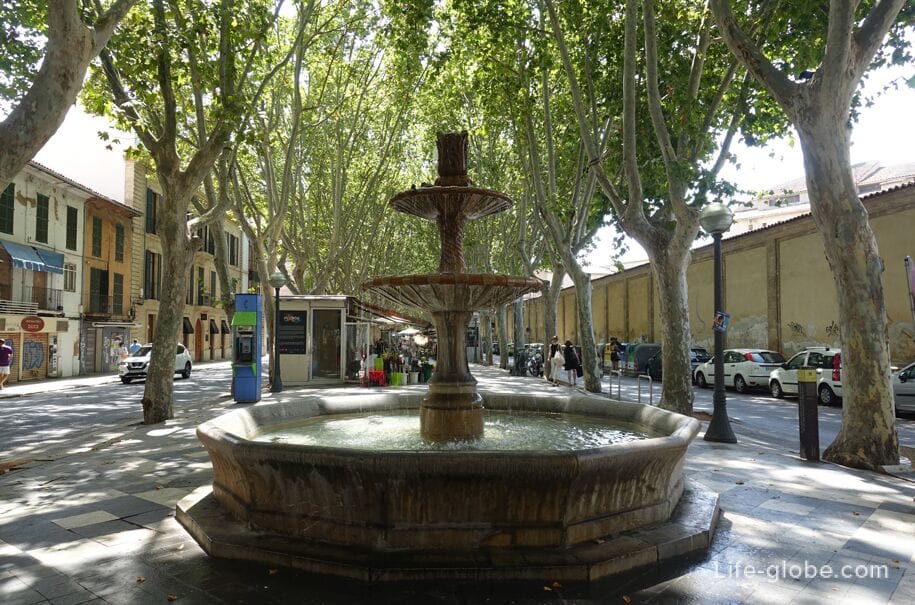
The Monastery of St. Magdalene (Convent de Santa Magdalena de Palma) is a religious landmark of the city, consists of a two-story monastery and an attached church of the same name.
The building is made in the Gothic style with later transformations (the beginning of the fourteenth century), while the church belongs to a complete reconstruction carried out in 1740.
The most important element of the church is the pantheon of St. Catalina Thomas (the city of Valdemossa - 1533, the city of Palma - 1574). The incorruptible body of Santa Catalina is kept in a silver sarcophagus with a glass part.
Church address: Plaza de Santa Magdalena, 2. More about the church and monastery of St. Magdalene...

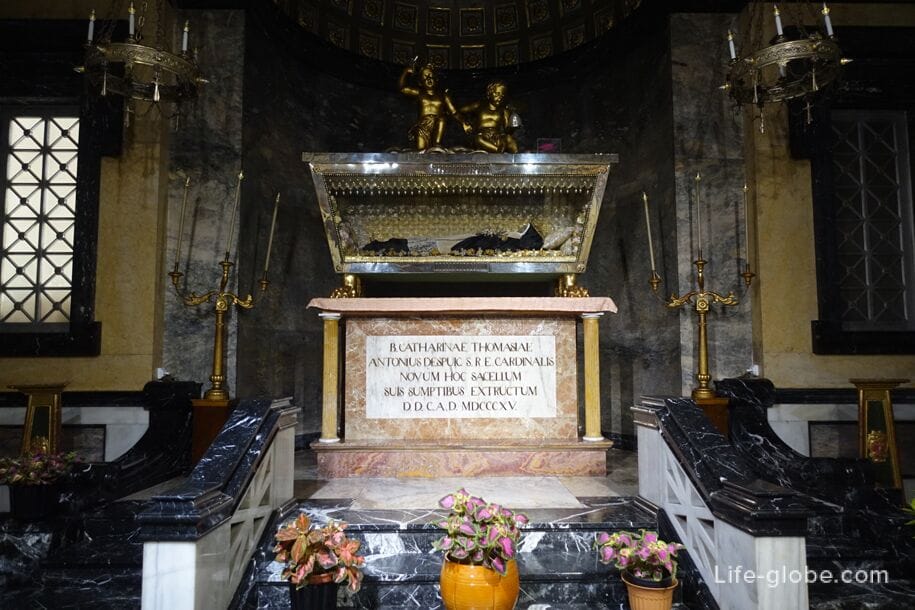
The La Misericordia Cultural Center is located on the site of the old Camp Roig Cemetery. Construction began in the 17th century to house a charitable foundation for the reception of the homeless, but work continued until the 19th century.
In the upper part of the building, two building blocks that once belonged to the men's and women's departments have been preserved.
A large trapezoidal courtyard with porticos stands out from the architectural complex: with Doric columns on the ground floor and Ionic columns on the second floor.
Since 1977, the foundation has been functioning as a cultural center. It houses the Handicraft Culture Library, the archive of the Old Provincial Council, the Luis Alemani Library (specializing in Balearic themes) and the Arxiu de la Imatge i el So de Mallorca (the Archive of Images and Sounds of Mallorca). Temporary exhibitions and sculpture shows are held in the old chapel in the garden. There is also a small room in the center where works from the collection of Croatian artist Christian Krekovic (1901-1985) are exhibited.
The address of the center: Plaça de l'Hospital, 4.
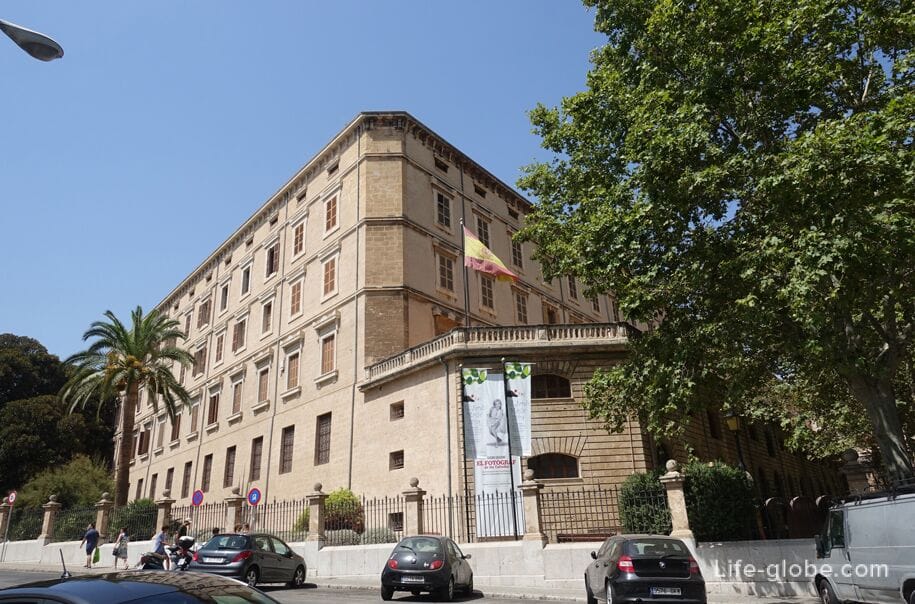
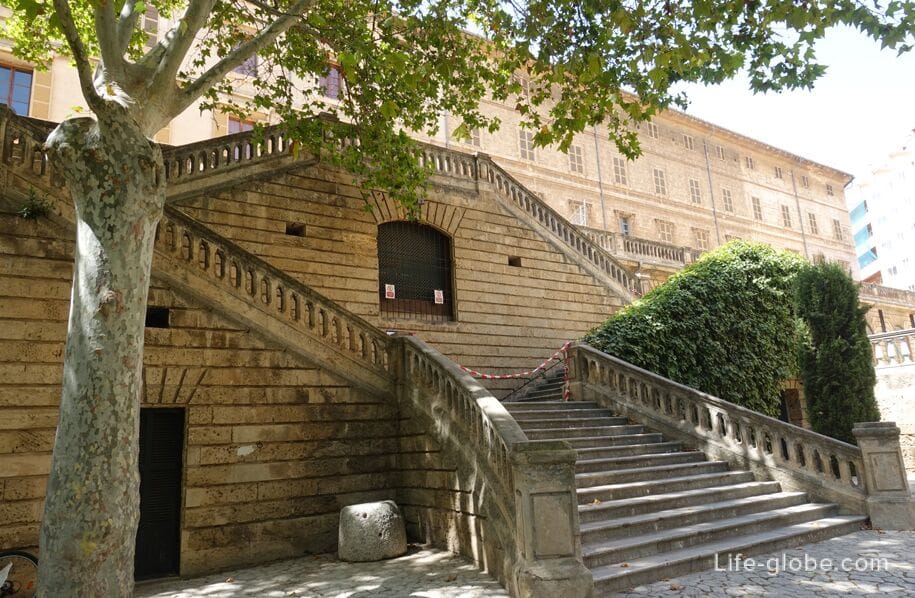
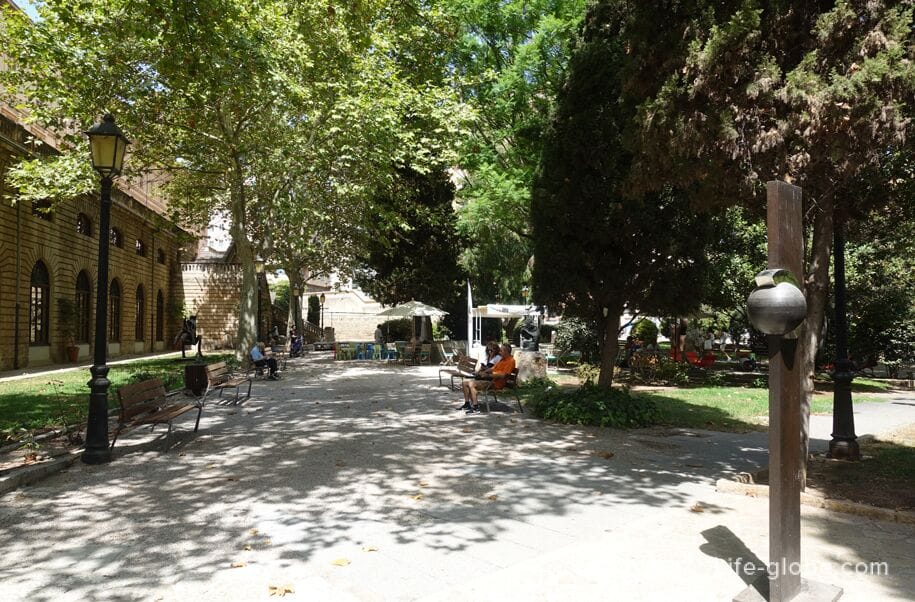
Near the cultural center, on Roma Street (Via Roma), buildings in characteristic "historical major" styles are notable.
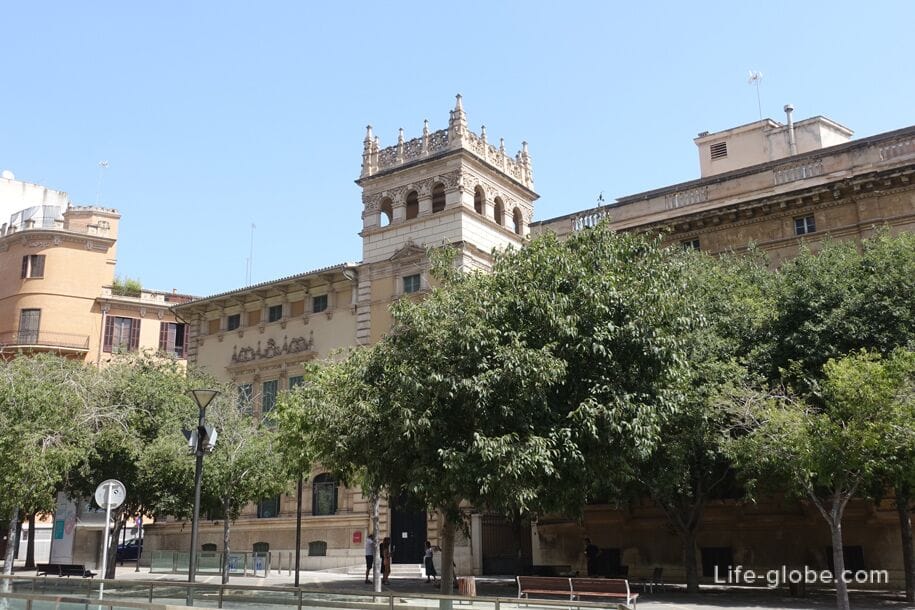

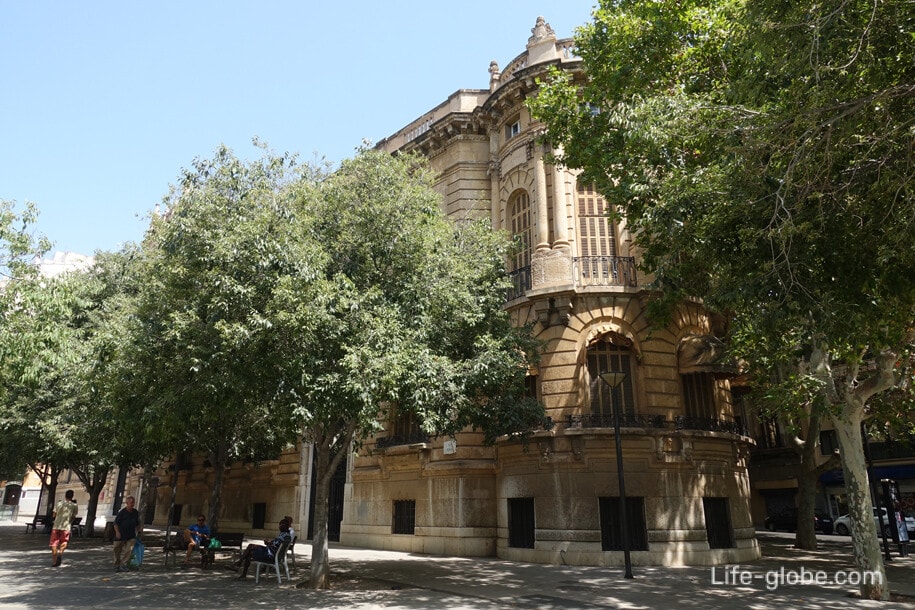
The church of Sant Jaume or Jaime (Parroquia de Sant Jaume) dates back to the 13th century and is made in neoclassical style.
Parish address: Carrer de Sant Jaume, 10.
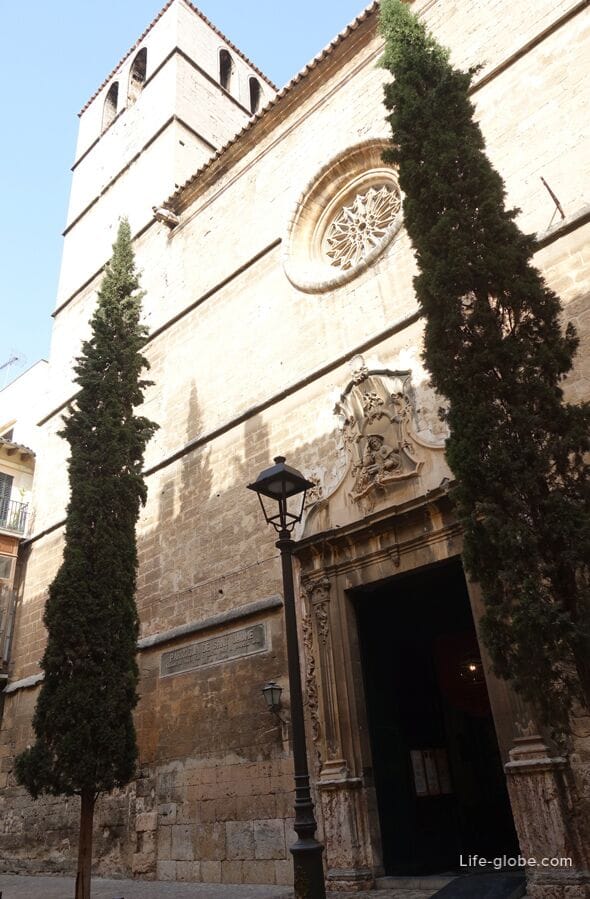
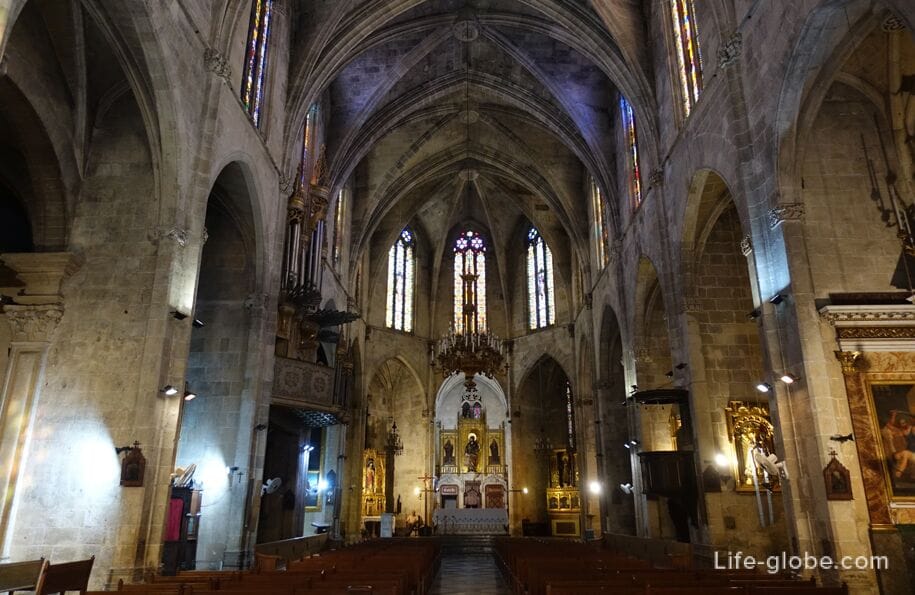
At this place, in the eastern part of the old town, there was once a fortified gate to the city of Gumara (Torres de Gumara / Temple), the fortress of Gumara. The two square entrance towers with the city gate between them were part of a fortress built in the Moorish period between 902 and 1231.
After the Catalan conquest of Majorca, King Jaume I gave Gumara to the Knights Templar, who walled up the gates, and since then they have become known as the Temple Castle, Temple House or simply Torres del Temple.
Torres del Temple was declared an object of cultural interest in 2005, and in 2007 it was bought by the City Council of Palma to prevent its conversion into apartments.
The gate can be seen on Temple Street.

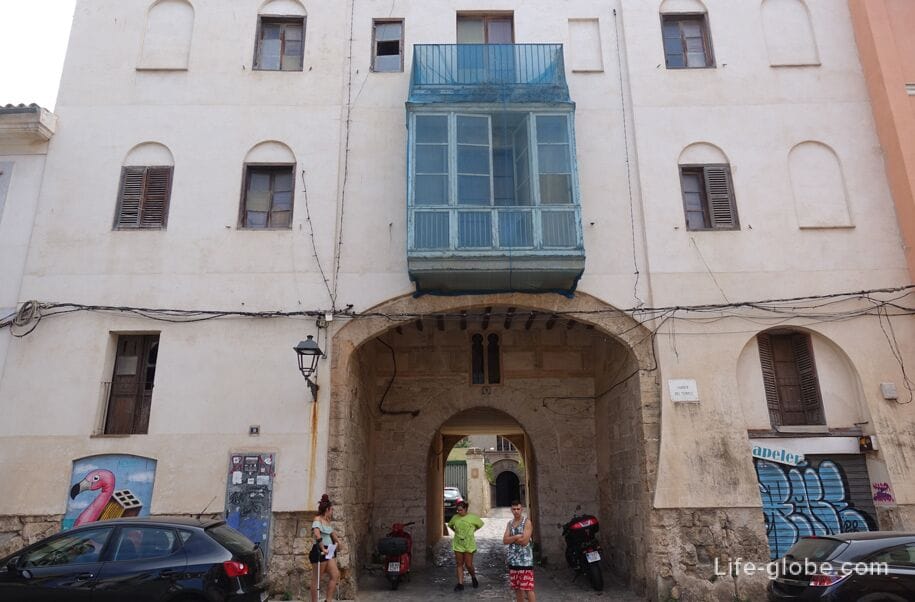
In addition to those listed, there are other churches, historical monuments and buildings in the historical center of Palma, in some of which you can see courtyards characterized by a mixture of elements from different eras.
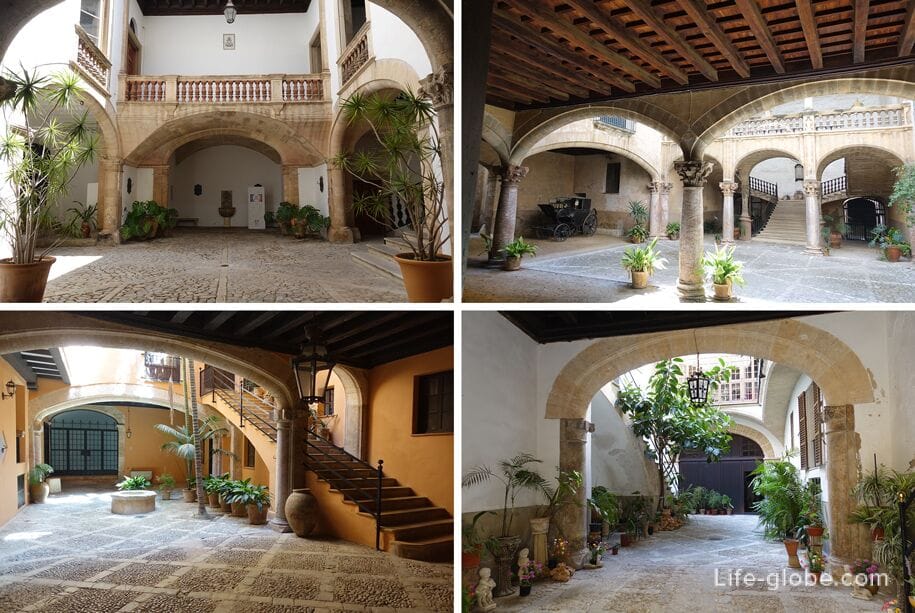
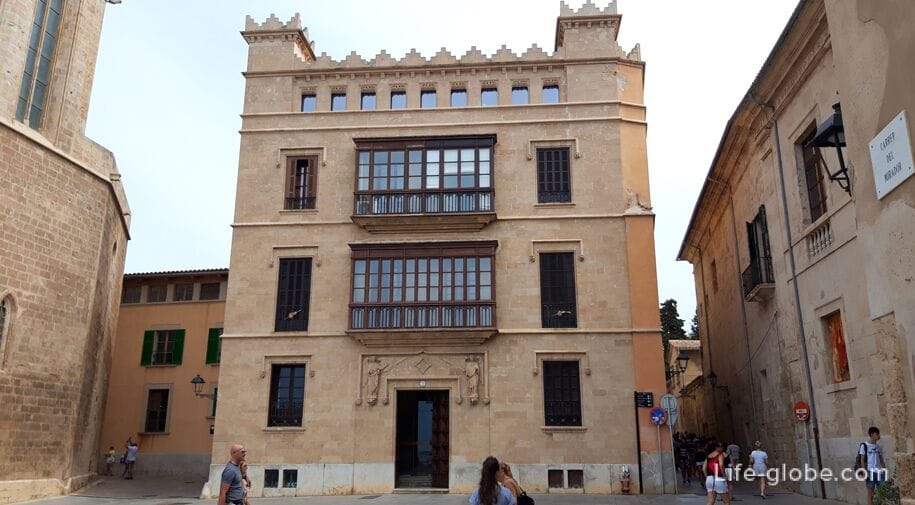


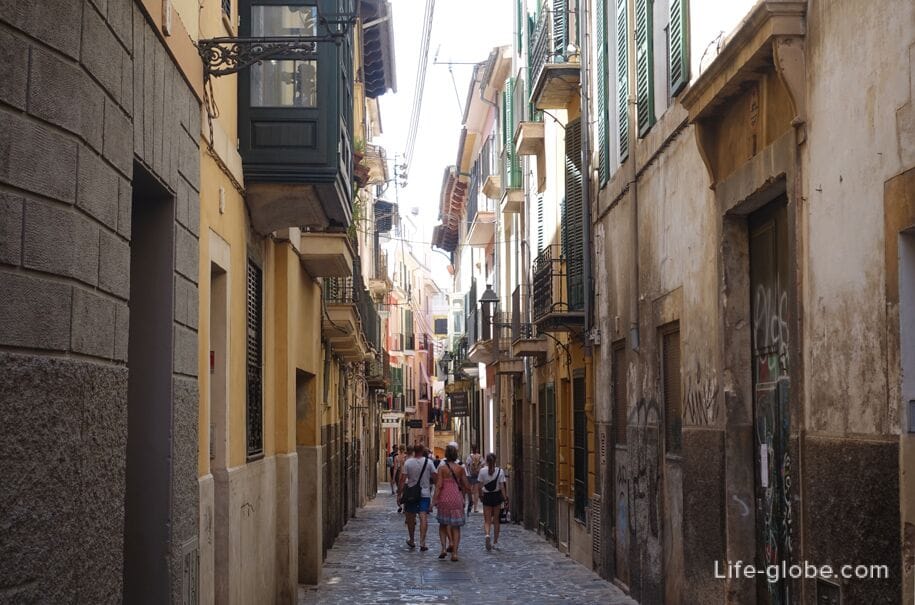
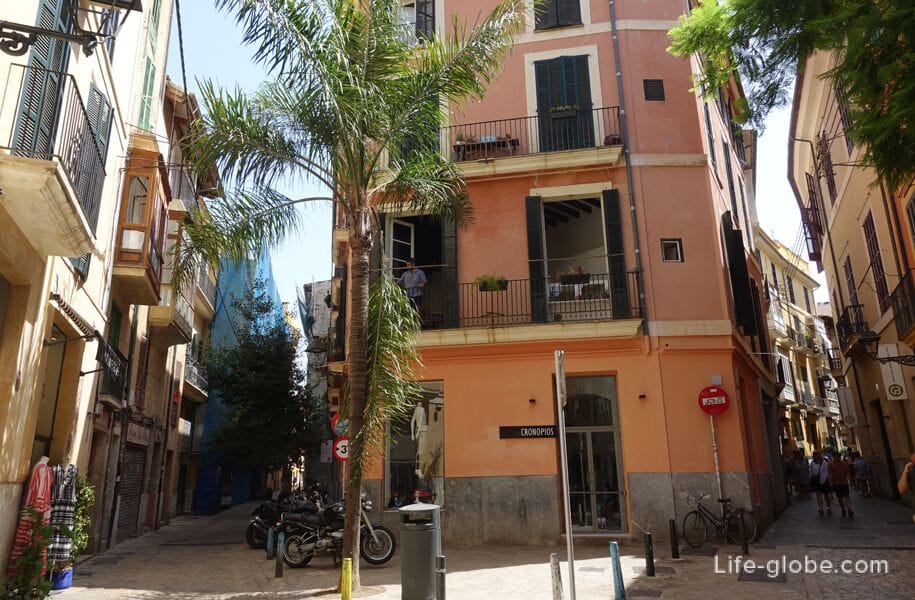
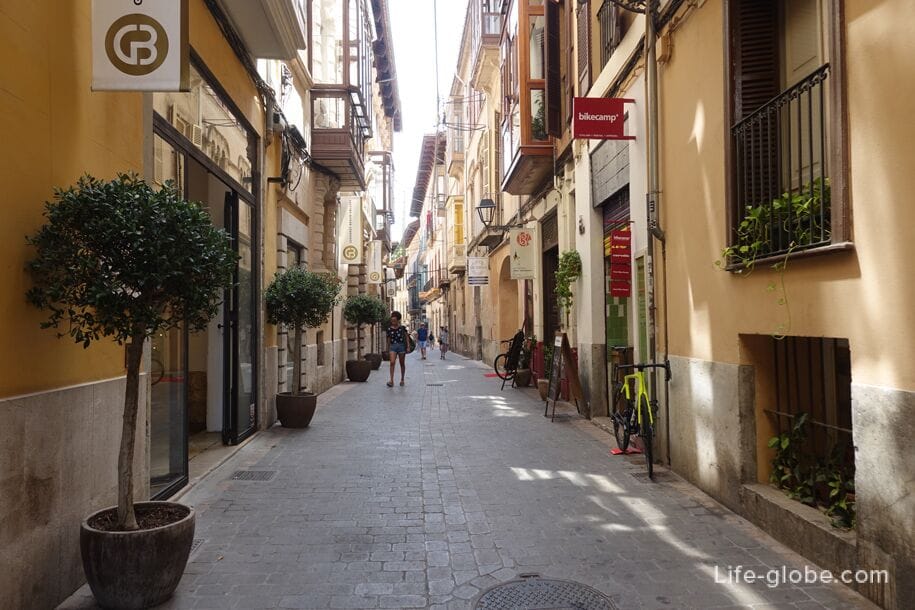
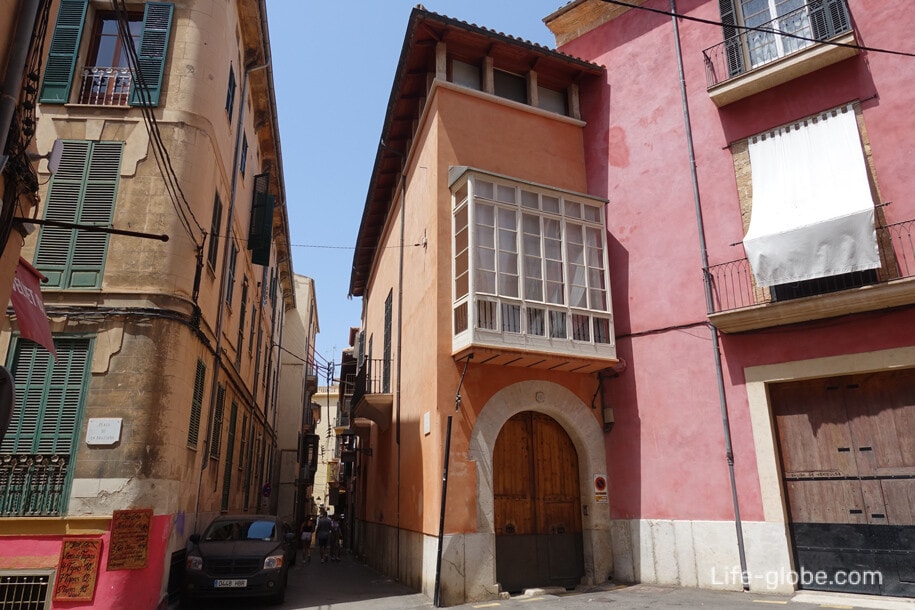
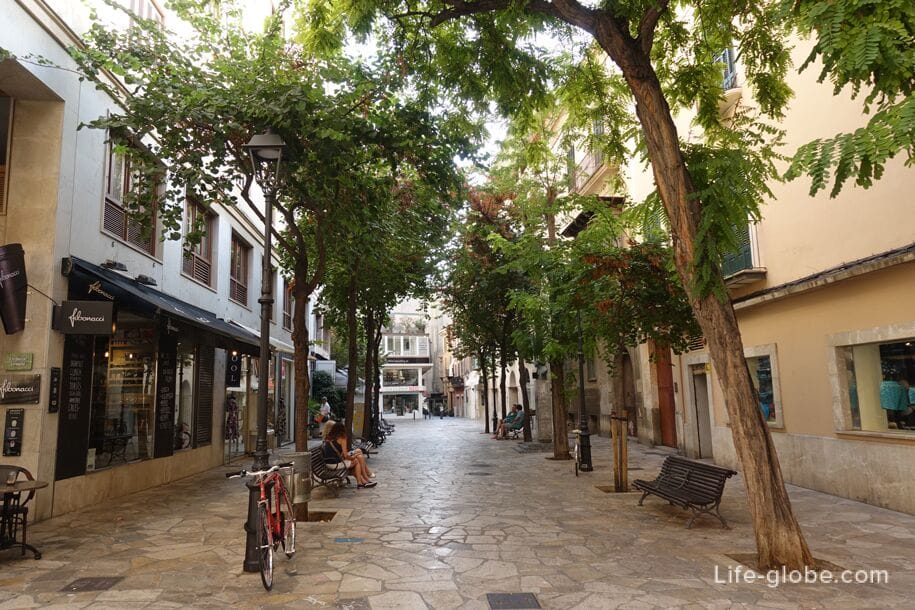
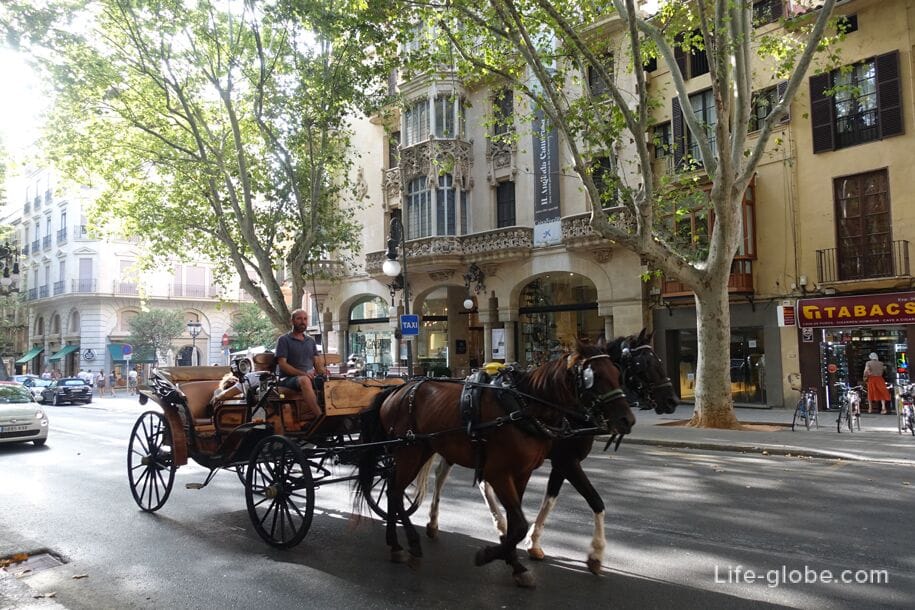
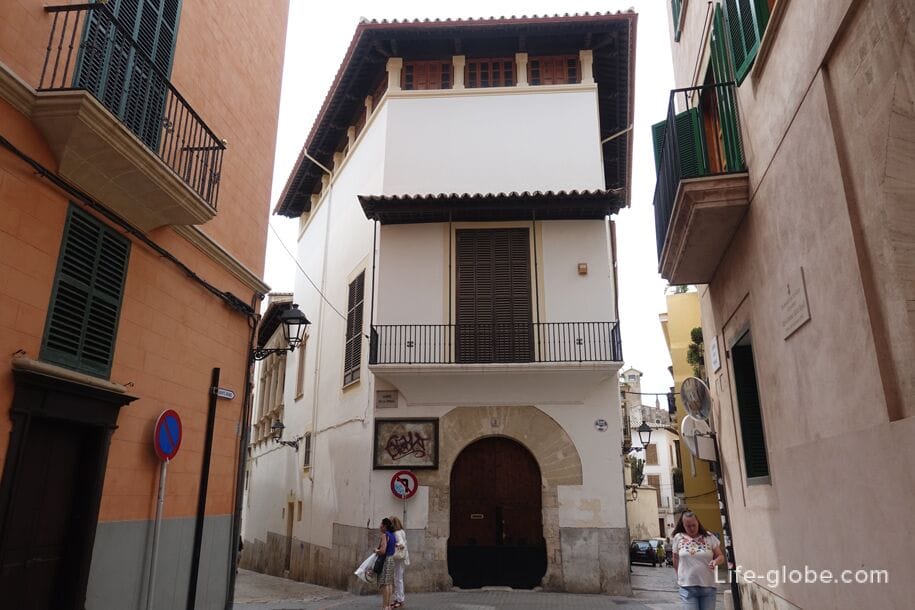
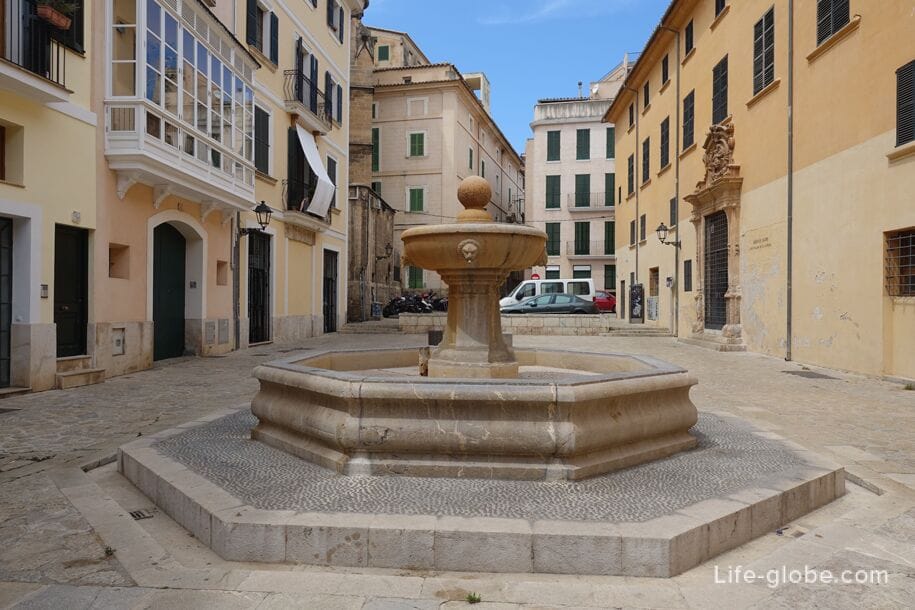
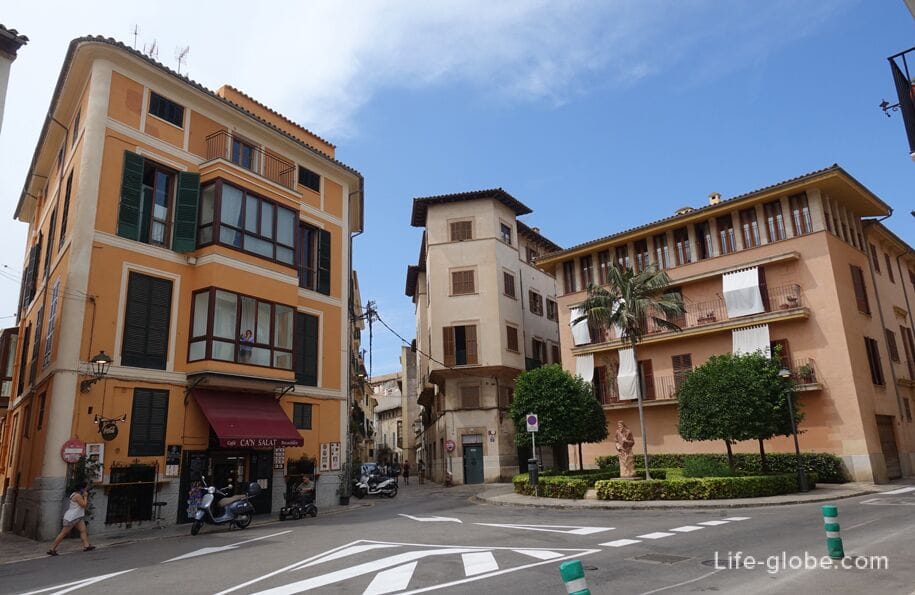
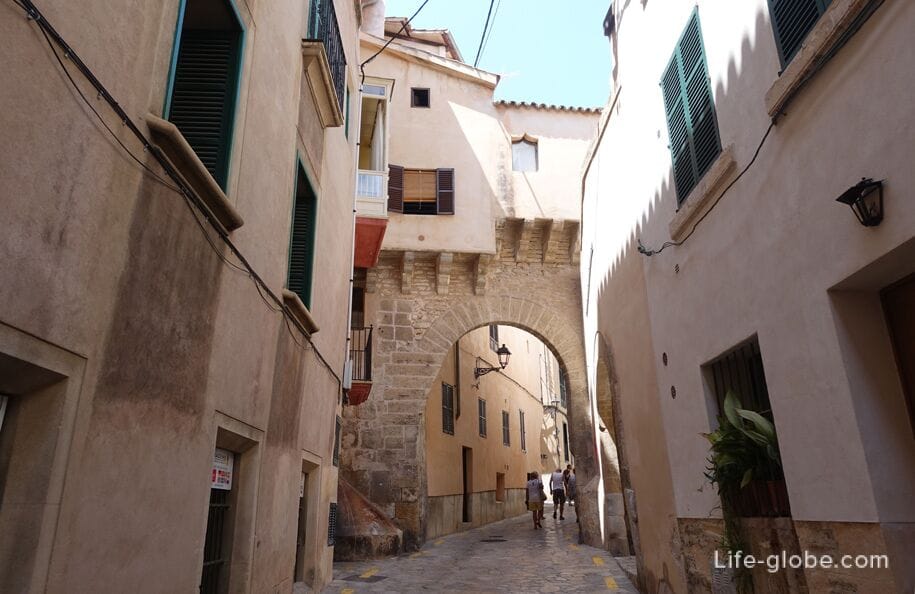

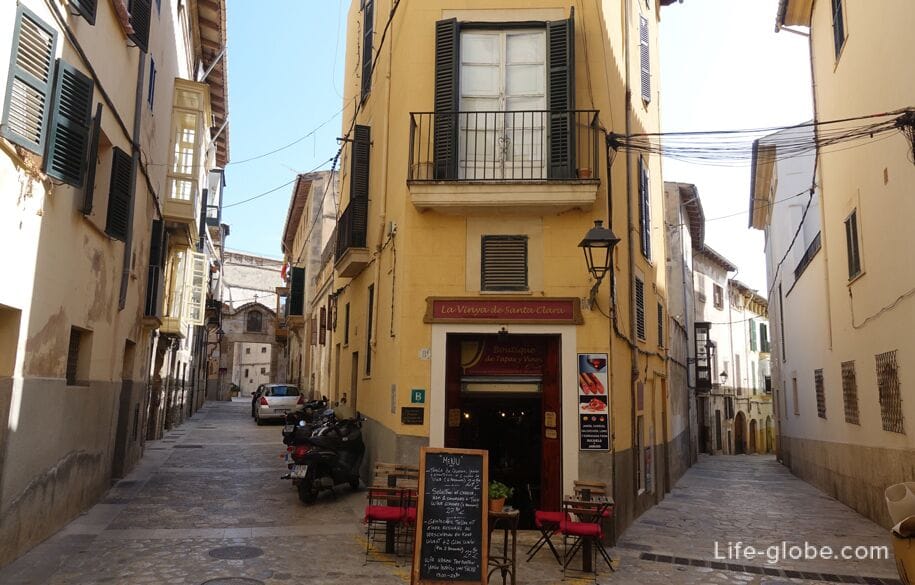
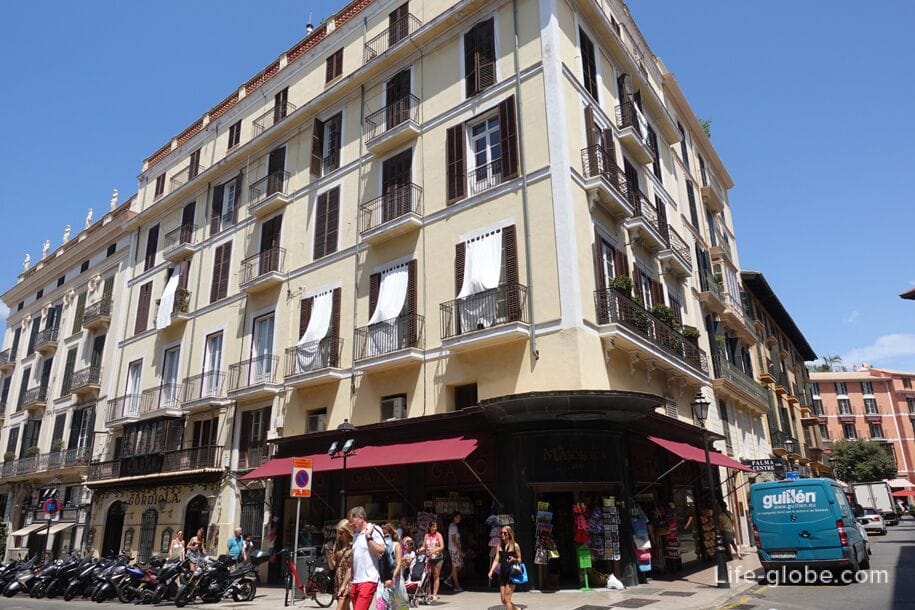
More information about all the sights in Palma can be found here...
There are many accommodation facilities in the historical center of Palma, ranging from 5-star hotels with swimming pools and panoramic terraces overlooking the city and the sea, and ending with apartments (separate apartments with all amenities), guest houses and hostels.
Of the best accommodation facilities
The 5-star Sant Jaume Hotel features a restaurant, free Wi-Fi, a free spa area with an indoor pool and sauna, as well as an outdoor mini pool on the roof terrace.
The rooms are equipped with air conditioning, a flat-screen TV, a minibar, a safe, a coffee/tea maker, a private bathroom with bathrobes, slippers, free toiletries and a hairdryer with a diffuser and a hair straightener.
Breakfast may be included in the room rate. Link to the hotel
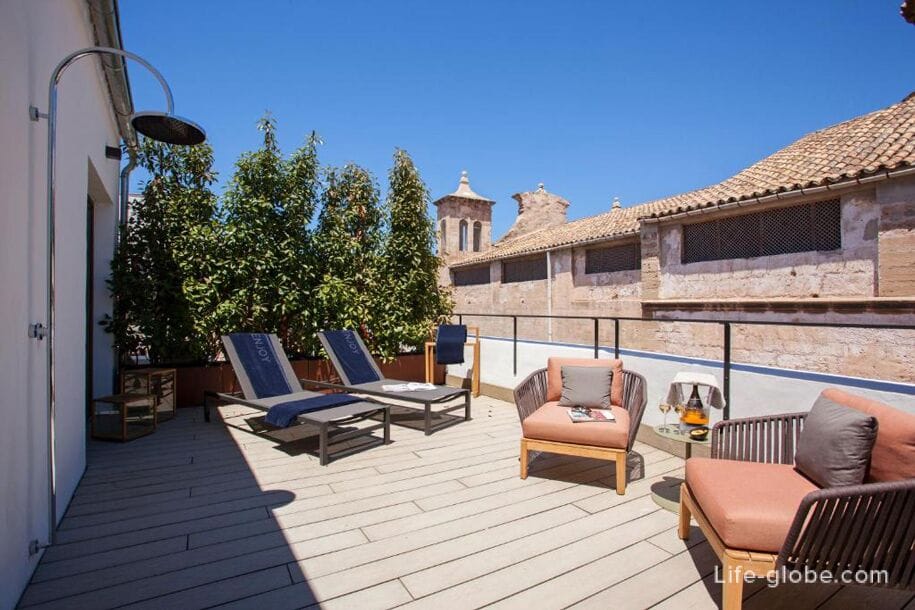
The 5-star boutique Hotel Can Alomar offers free Wi-Fi, a restaurant, a relaxation area located on a sun terrace with a mini pool with a hot tub.
The rooms are equipped with satellite TV, king-size beds, seating area, mini-bar, safe, coffee/tea maker. The bathrooms have a bath or shower, hairdryer with diffuser, hair straightener, free toiletries, bathrobe and slippers.
Breakfast may be included in the room rate. Link to the boutique hotel

5-star boutique Hotel Can Cera - Adults Only, located in an 18th-century palace.
The hotel has a free spa center with a sauna and a hot tub, a terrace with panoramic views, a courtyard, a cafe, a bar and a restaurant.
The rooms are equipped with antique furniture, mini-bar, coffee maker/kettle, safe, flat-screen TV with satellite channels, air conditioning, free Wi-Fi, bidet, bathrobes, slippers, hairdryer with diffuser and hair straightener. Some rooms have a balcony or terrace.
Breakfast may be included in the room rate. Link to the boutique hotel
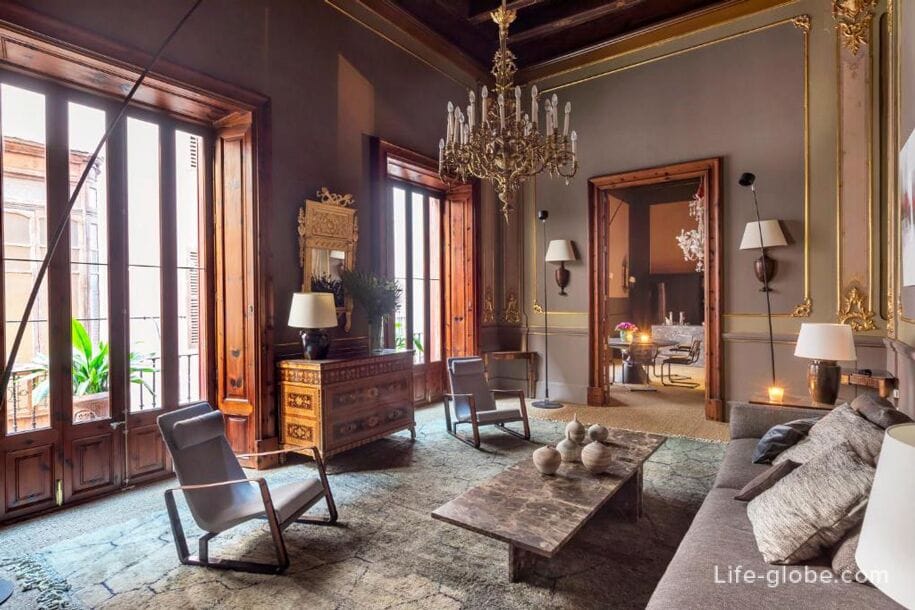
The 5-star Calatrava Hotel features a restaurant, private parking, free Wi-Fi, and a free spa area with a Finnish sauna and hot tub.
The rooms are equipped with a minibar, a safe, air conditioning, a flat-screen TV with Smart TV technology, a bathroom with bathrobes, slippers, free toiletries, a hairdryer with a diffuser and a hair iron.
Breakfast is served on the hotel's terrace overlooking the Mediterranean Sea. Link to the hotel
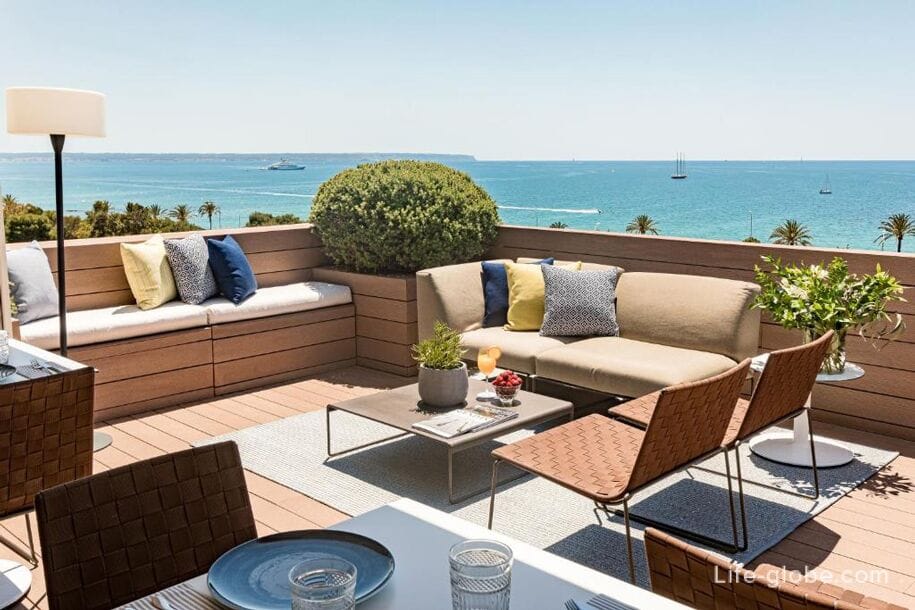
The 5-star Palacio Ca Sa Galesa Hotel features a rooftop terrace with buffet buffet and views of the Palm Cathedral, bicycle rental, restaurant, bar, spa and wellness center, free Wi-Fi, parking and family rooms.
The individually decorated rooms are decorated with works of art by Miro, Caldera or Bennasar. Each room has air conditioning, satellite TV, laptop safe, hot tub, DVD player, bathrobes and slippers. Link to the hotel

All accommodation facilities in Palma de Mallorca, including in the historical center, near the beaches and more remotely from those, can be viewed and booked here